Individual Vehicle Approval (IVA) for buses and coaches: help to get a pass
Updated 15 June 2017
Introduction
This guide tells you how to avoid the top 10 reasons buses and coaches in the M2/3 inspection category fail the IVA inspection:
- Section 52
- Headlamp aim
- General construction
- Statutory plates and Vehicle Identification Number (VIN)
- Masses and dimensions
- Seat belt anchorages
- end outline, side, stop & side marker lamps
- Seat belts
- Speed limiter
- Installation of lights
This guide tells you:
- how each item is inspected
- what to check before each item is inspected
- the required standard
Full compliance with this guide doesn’t guarantee a pass. You’ll need to view the IVA inspection manual for the full requirements and testing procedures needed to get your vehicle passed.
You must apply for vehicle approval if you’ve:
- built a vehicle
- rebuilt a vehicle
- radically altered a vehicle
- imported a vehicle
Vehicles in the M2/3 categories are defined as:
- M2 - Vehicles designed and constructed for the carriage of passengers with more than eight seats, in addition to the driver’s seat, and having a maximum authorised mass not exceeding 5 tonnes
- M3 - Vehicles designed and constructed for the carriage of passengers with more than eight seats, in addition to the driver’s seat, and having a maximum authorised mass exceeding 5 tonnes
With the IVA inspection some sections are covered by documentary evidence and for the other sections DVSA will examine the rest of the vehicle.
Difference between IVA and MOT
IVA inspections are different from the annual MOT test.
The IVA inspection looks at the way your vehicle is constructed or adapted, while the annual MOT test looks at roadworthiness of your vehicle.
Your vehicle might pass the MOT test, but that doesn’t mean it will pass an IVA inspection.
1. Section 52 A - Z
1.1 How Section 52 is inspected
Section 52 is a large section of the IVA inspection manual and where the most common test failure items occur.
This section covers many parts of the vehicle that aren’t covered with a specific section in the IVA inspection manual.
Not every item in section 52 of the IVA inspection manual is covered below, only the most common problems.
Section 52a – tilt test

Example of a tilt test.
The image above shows a bus tilt test.
DVSA will require documentary evidence of a successful test for most vehicles.
See section 52a (tilt) of the IVA inspection manual.
Section 52c – area available for passengers

DVSA will measure standing areas.
DVSA will measure both seated and standing areas to check the declared amount of passengers can be accommodated.
Section 52d - markings
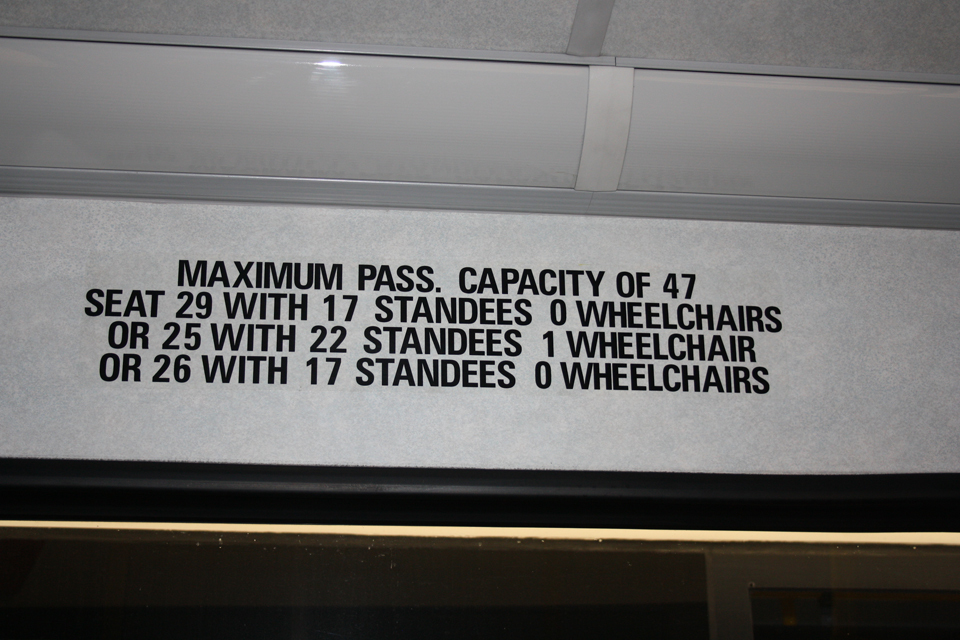
Example of markings.
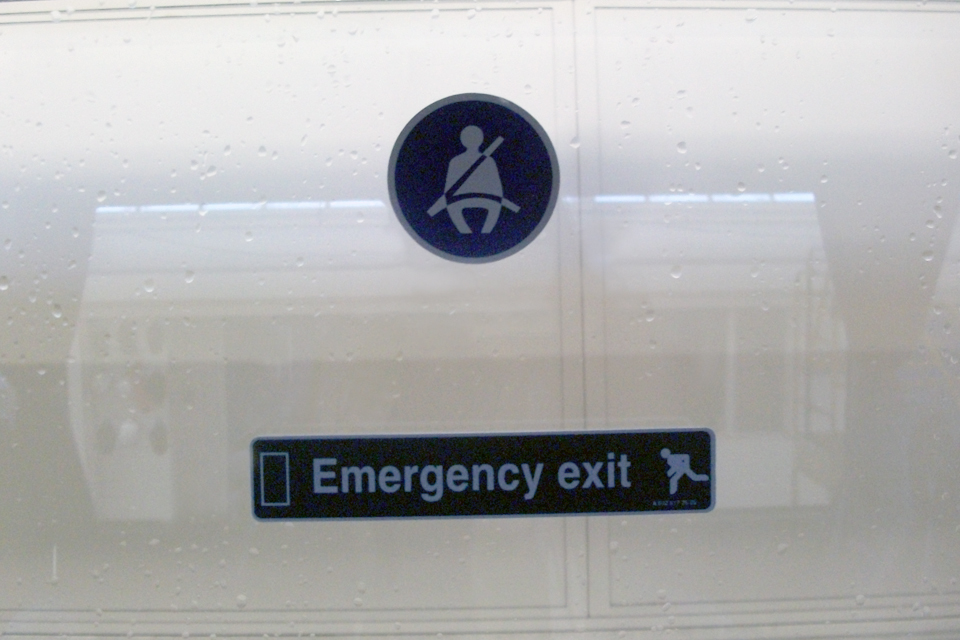
Example of markings.
It’s common for a vehicle to arrive with incorrect or missing markings. Follow the requirements in section 52d (markings) of the IVA inspection manual for accepted markings.
Bring spare markings with you to the test, as if time is available the vehicle examiner may allow you to fit them and issue a Pass Rectified at Station (PRS) to avoid the need for a retest.
It’s the vehicle examiner who will determine whether this can be done.
Section 52f - electrical equipment

Batteries must be secure and accessible.
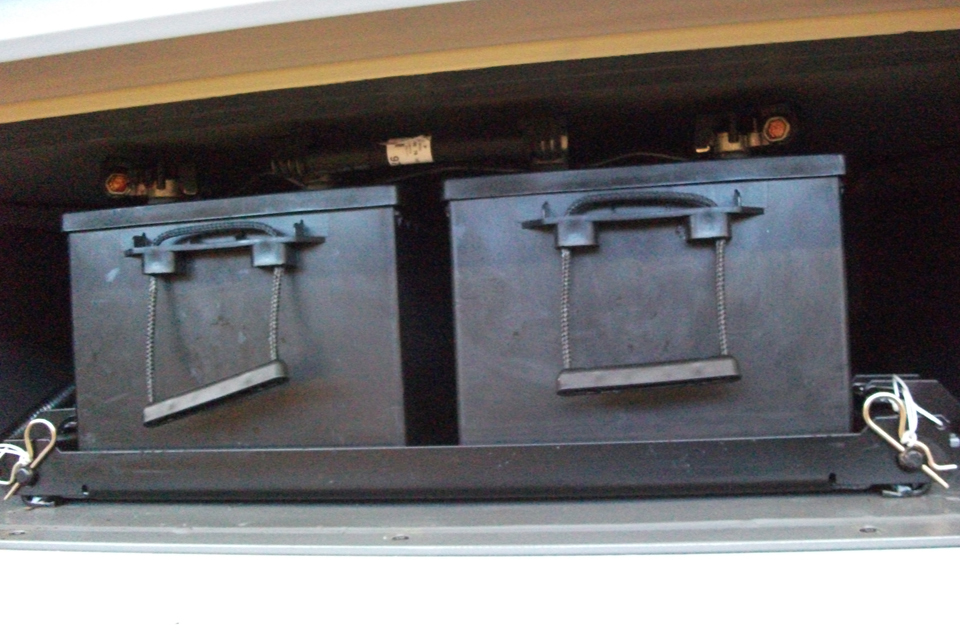
Batteries must be separated from the passenger compartment.
Batteries must:
- be secure and accessible,
- be separated from the passenger compartment
- have all terminals insulated
Section 52g - fire extinguisher and first aid
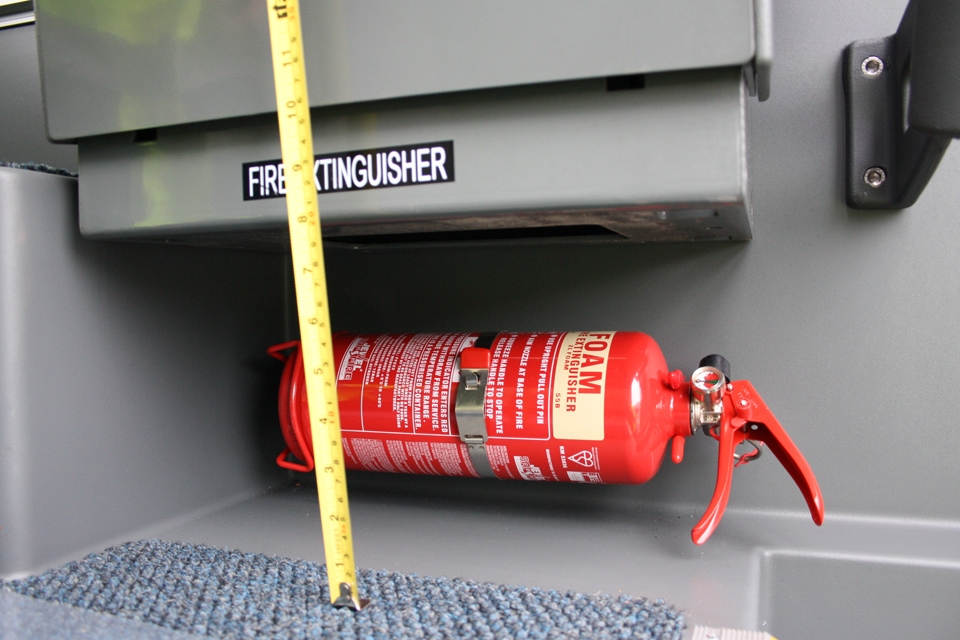
Not allowed: not enough space provided.
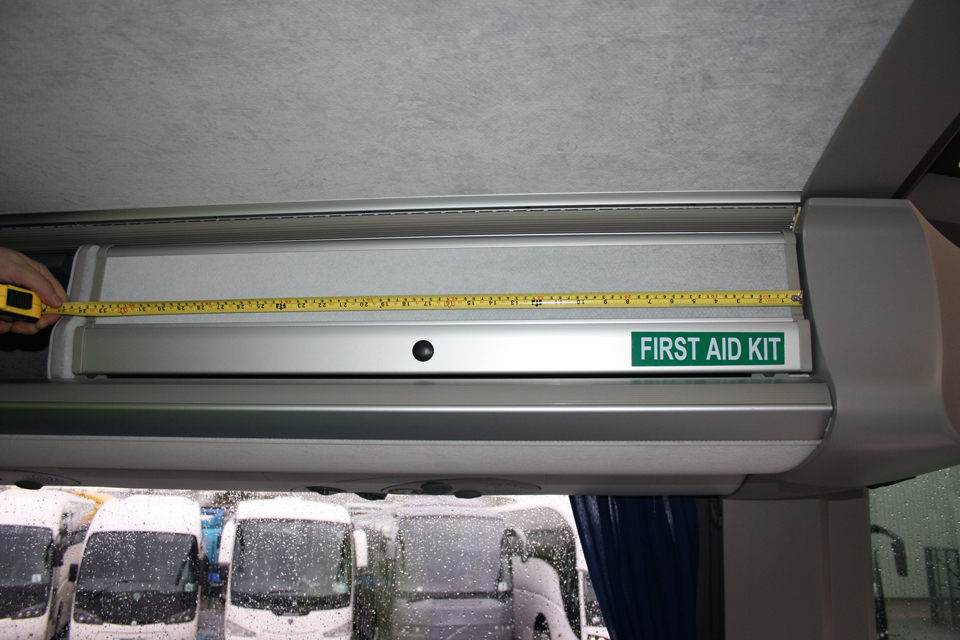
Allowed: first aid storage clearly marked and of sufficient size.
DVSA will check that the fire extinguisher and first aid storage areas are:
- of the correct and sufficient size
- correctly marked
The first image above shows that DVSA will measure to make sure sufficient space is available.
The second image above shows, that where the location isn’t obvious, it must be clearly marked. DVSA will check to make sure its of sufficient size. The example image of the first aid storage shows that it’s clearly marked and is of sufficient size.
Section 52h - number and location of exits
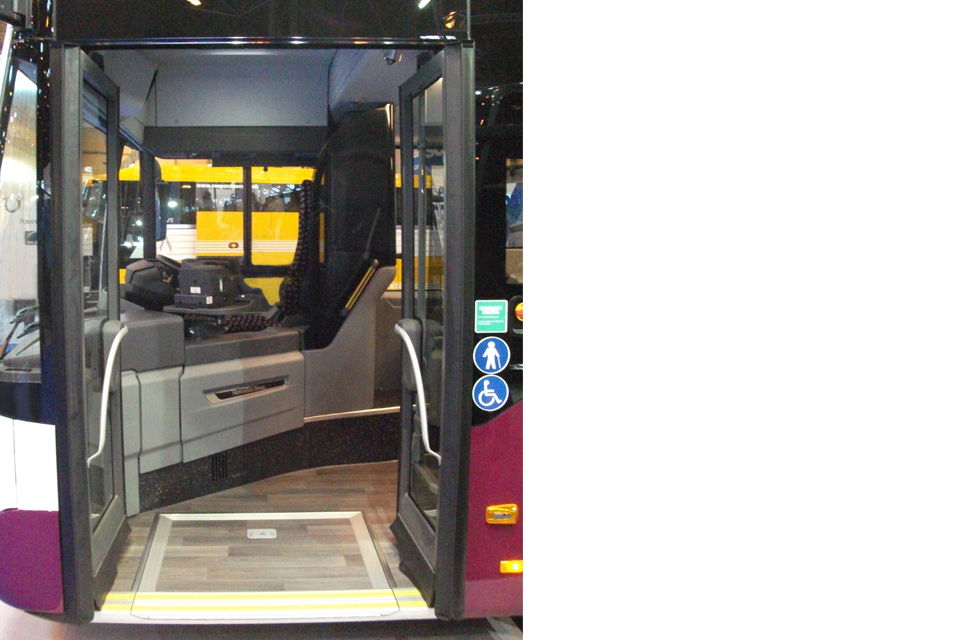
Example showing location of exits.

Example showing location of exits.
DVSA will check:
- that the number of exits and doors, including emergency exits, are relevant to the number of passengers
- the location of the exits and doors
There are different standards to apply that depend on the class of bus and the type of exits that need to be provided.
The required standards are in section 52h (number and location of exits) of the IVA inspection manual.
Section 52i - service doors
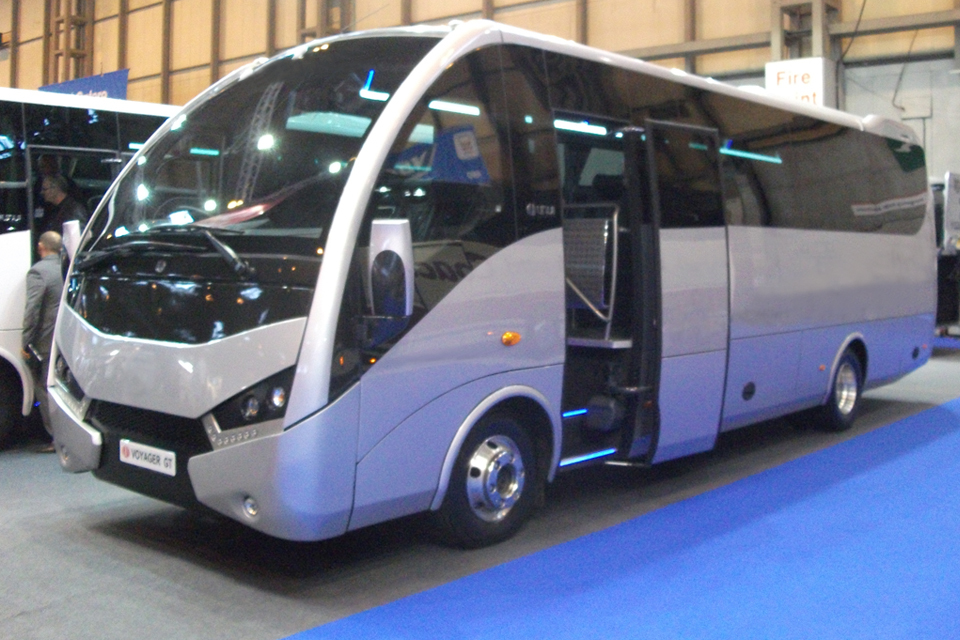
Example of service door.
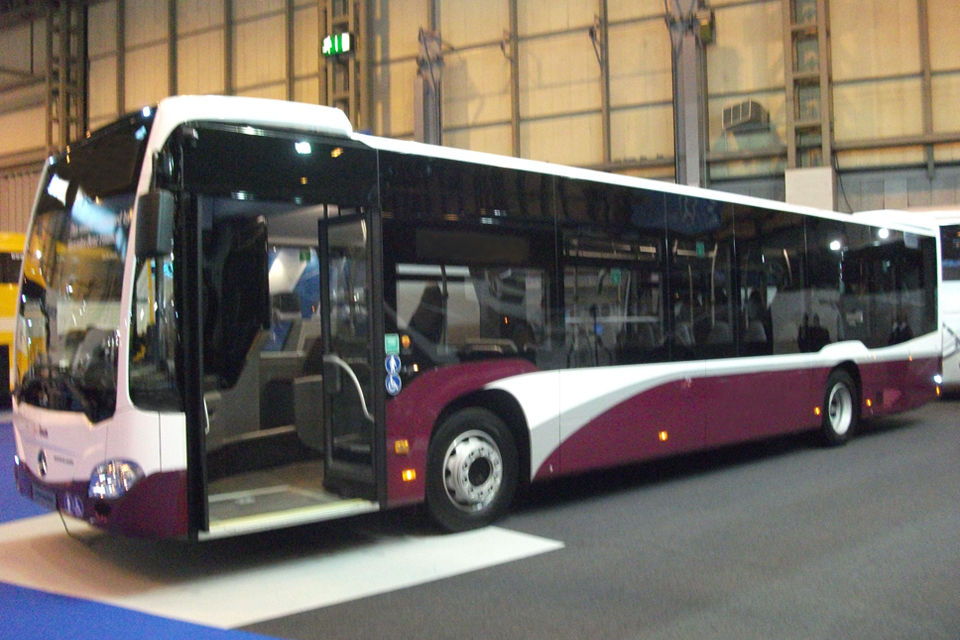
Example of service door.
Service doors is a large and complex section of the IVA inspection manual.
DVSA will check service door:
- dimensions
- measurements
- controls
- hinges
- operating systems
- other items
The most common problem DVSA sees at test are with the markings and dimensions of service doors.
Before the test, refer to the specific required standards for the your class of bus and coach in section 52i (service doors) of the IVA inspection manual.
Section 52j - emergency doors

Example of an emergency door.

Example of an emergency door.
DVSA will:
- use a body form template to check access to the door
- measure the dimensions of the door itself
There are different requirements for different bus and coach classes that relate to how the emergency door is operated.
You’ll need to apply the required standard, for your bus or coach, to the emergency door that is fitted.
See section 52j (emergency doors) of the IVA inspection manual.
Section 52k - emergency windows
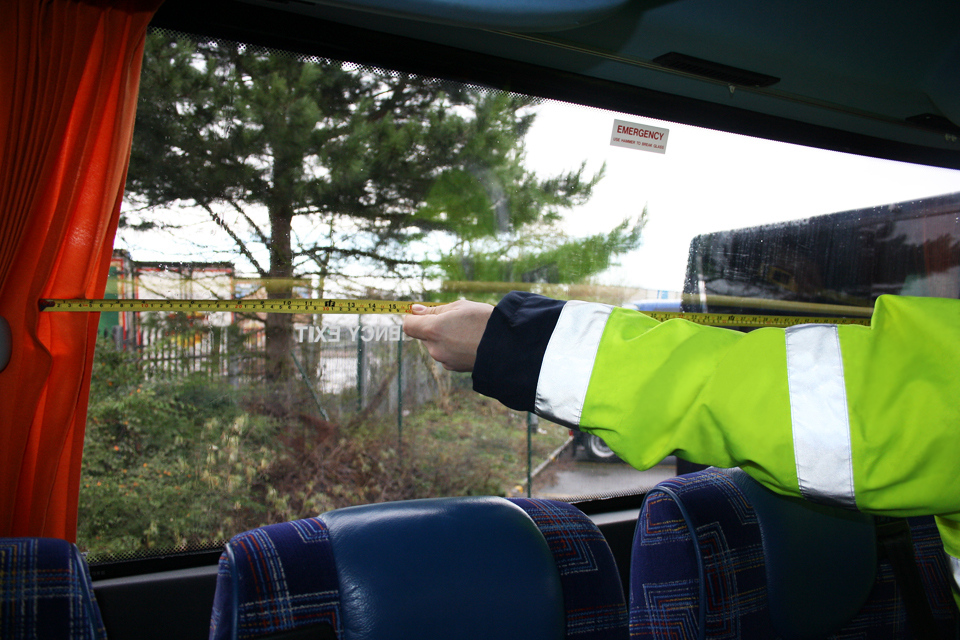
DVSA will measure the size of the emergency window.
As shown in the image above DVSA will measure the size of the emergency window to make sure it’s of sufficient size.
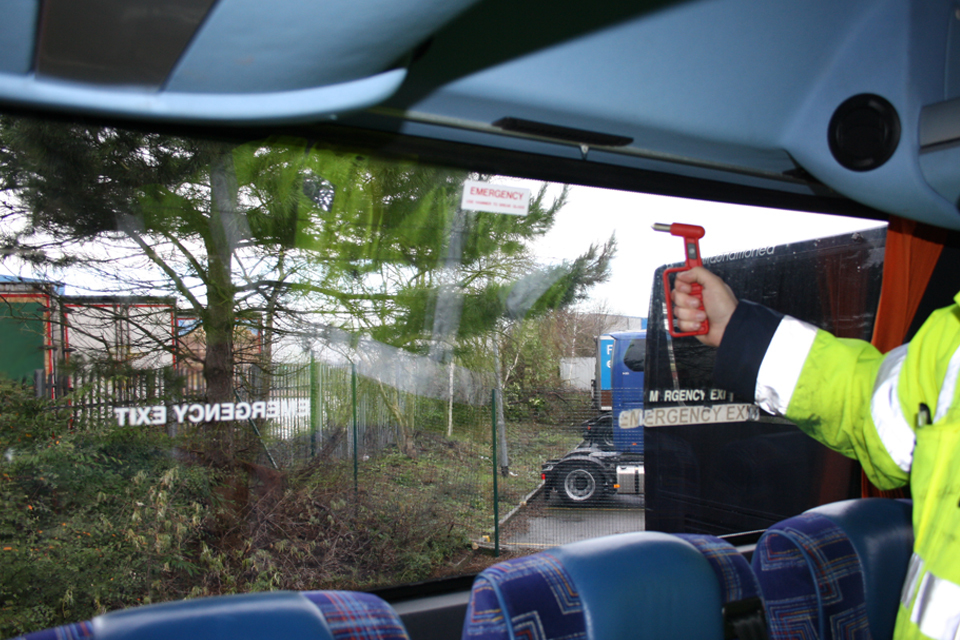
For break glass emergency windows a suitable device must be available adjacent to the window.
For break glass emergency windows a suitable device must be available adjacent to the window.
DVSA will use a gauge to determine the access to the window.
For hinged and ejectable emergency window exits DVSA will check for the correct height of lower edge.
Section 52l - emergency hatches
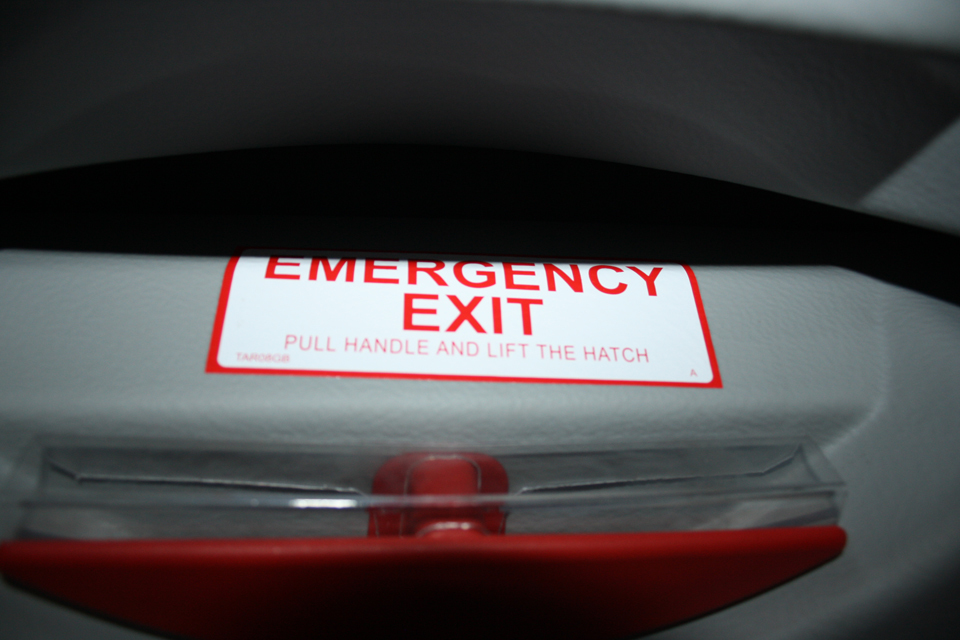
Example of an emergency hatch.
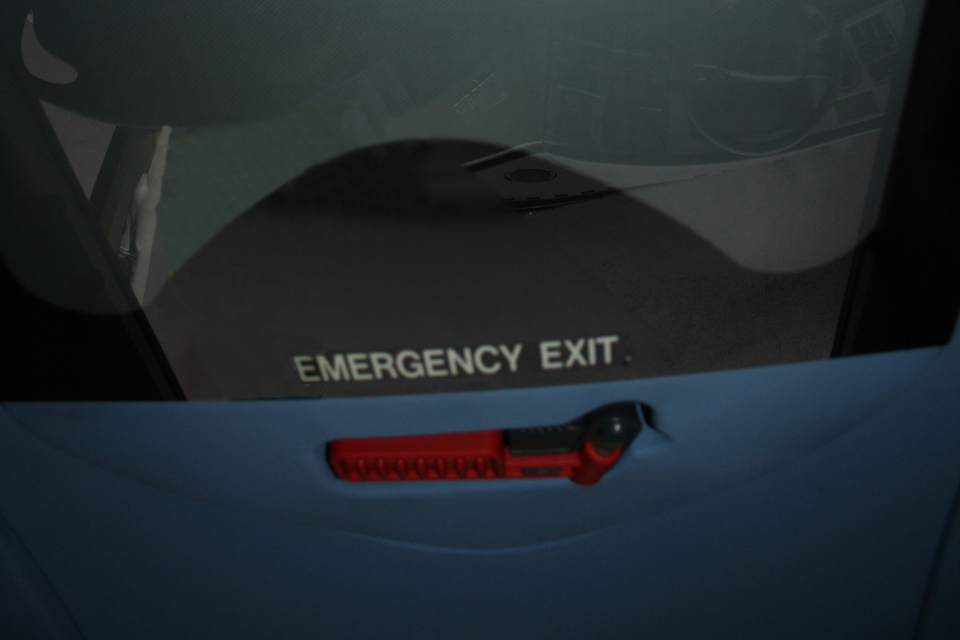
Example of an emergency hatch.
The IVA inspection manual lists the dimensions for all hatches and roof hatches. This will include requirements for:
- audible warnings
- attachments of an emergency hatch
- break glass types
- other types
See section 52l (emergency hatches) of the IVA inspection manual to determine what type of emergency hatch is fitted to your vehicle and apply the required standards.
Section 52m - gangways and stairways

DVSA will check the size of the gangway.
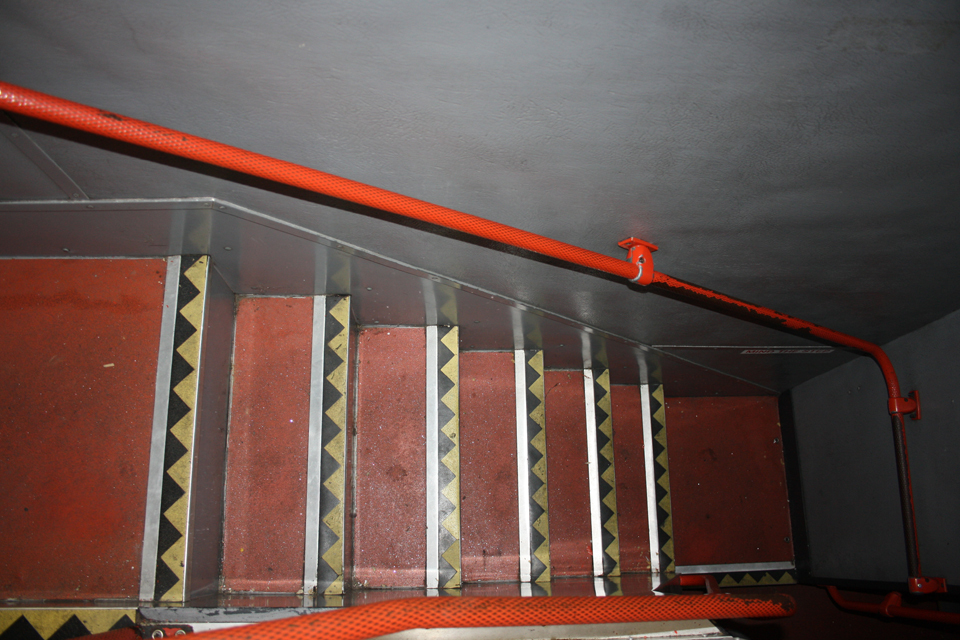
DVSA will check the size of the staircase.
DVSA will use a gauge/template to determine if the size of the gangway and staircase is sufficient.
Use a ‘inclinometer’ to check that the angles of the slope of the gangways to make sure they meet the required standard.
There are differences for each class of bus and coach with different requirements for:
- side facing seats
- front facing seats
- rear facing seats
See section 52m (gangways and stairways) of the IVA inspection manual for the required standards.
Section 52n - steps

DVSA will check the dimensions, slope and surface of steps.
As shown in the image above DVSA will check the:
- step dimensions
- slope of the steps
- slip resistant surface
There are different requirements for retractable steps.
The required standards are different depending on:
- the bus or coach class
- passenger capacity
- where the steps are located
- emergency door access
- type of suspension
See section 52n (steps) of the IVA inspection manual for the required standard.
Section 52o - handrails and handholds
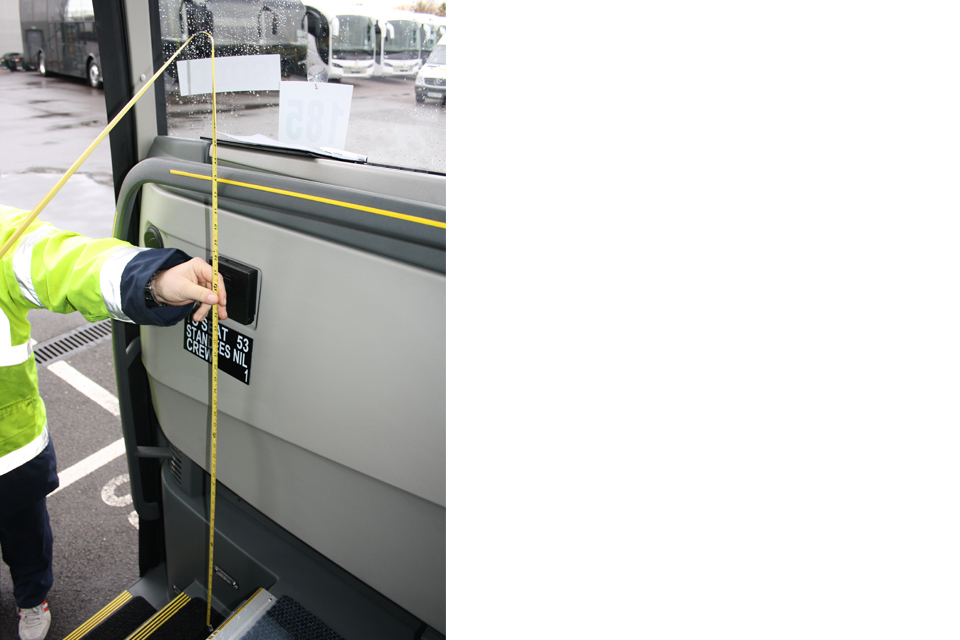
DVSA will check the handrails and handholds for positioning, size and clearance.

DVSA will check the handrails and handholds for positioning, size and clearance.
As shown in the first image above, DVSA will check the handrails and handholds for:
- amount fitted
- positioning
- size
- clearance
There are additional requirements, if you’ve a bus or coach without a roof. See section 52o (handrails and handholds) of the IVA inspection manual.
There are different required standards for each class of bus and coach. See section 52o (handrails and handholds) of the IVA inspection manual.
Section 52p - passenger seats and space
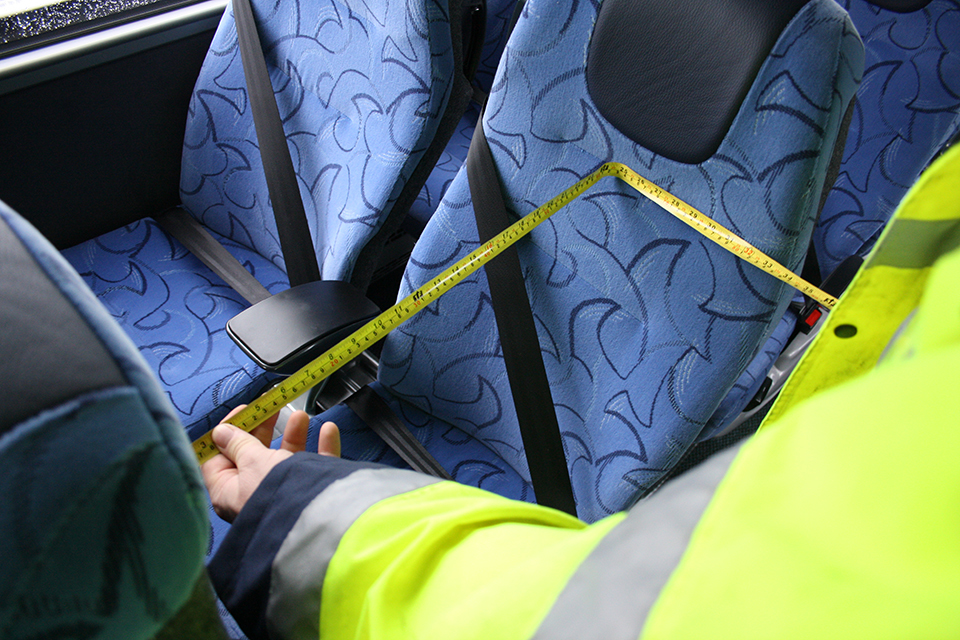
DVSA will measure passenger seats for size and space.

DVSA will measure passenger seats for size and space.
DVSA will inspect passenger seats and space for:
- dimensions
- spacing
- free space
- depth of cushion
- intrusions
- other items
This is a complex area and each bus or coach type will have different requirements. Section 52o (passenger seat and space) of the IVA inspection manual has notes and diagrams/drawings to help you meet the required standard.
Only those vehicles that aren’t designed to carry more than eight passengers, may have seats marked ‘not for use’ when the vehicle is ‘in motion’.
Section 52q - communication with driver

Example of device used to get the drivers attention.

Example of device used to get the drivers attention.
The images above show the different ways to get the attention of the driver. Each bus and coach type have different requirements.
See section 52q (communication with driver) of the IVA inspection manual for the required standard.
Section 52s - doors and interior compartments
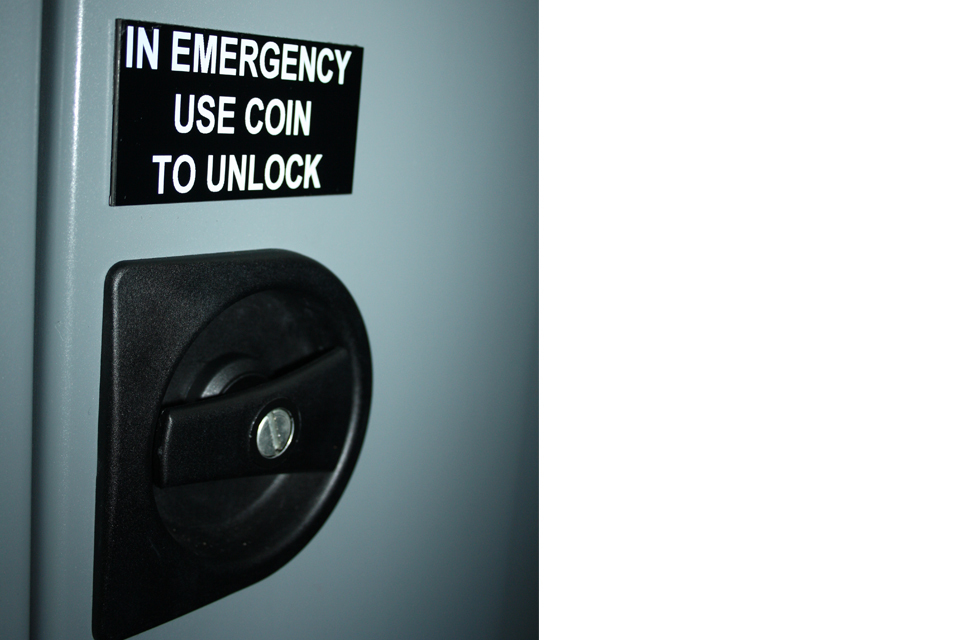
Example of an internal compartment and how it can be opened from the outside.

Example of an internal compartment.
All internal doors must be self closing.
DVSA will check that when an internal door is open that it mustn’t conceal:
- another door handle, etc
- any obligatory markings for service and emergency door/exits
- a fire extinguisher
- a first aid kit
Where the compartment can be occupied by a passenger, for example a toilet, there must be a way to open it from the outside in an emergency (as shown in the first image above).
Section 52t - artificial lighting
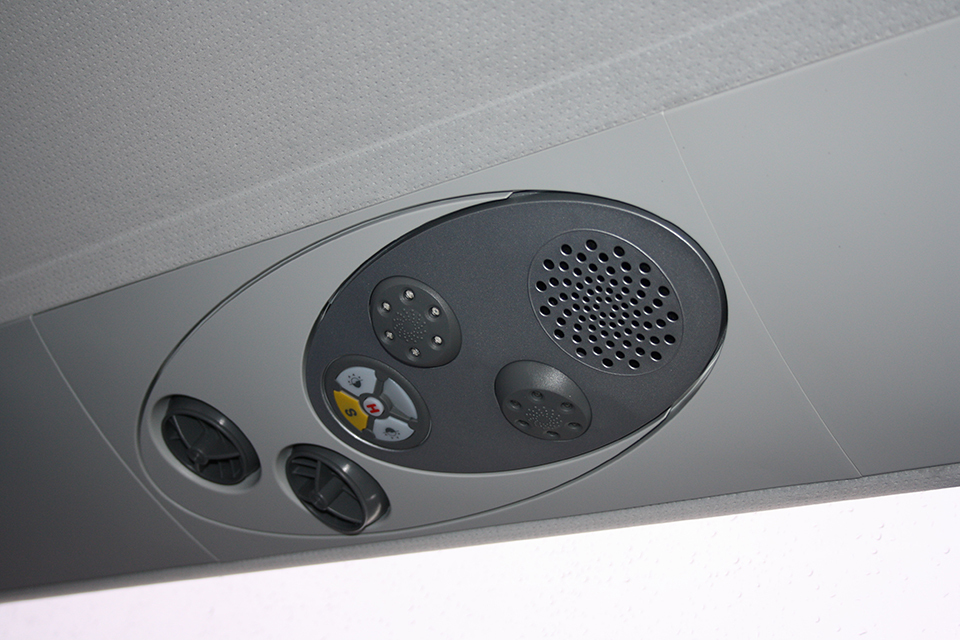
Example of artificial lighting.
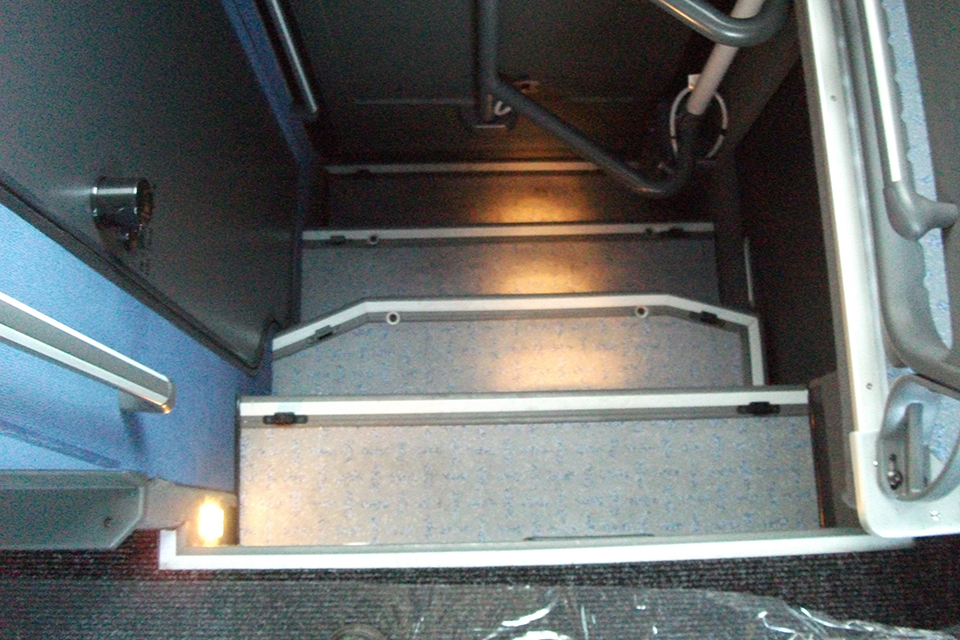
Example of an area lit by artificial lighting.
There are specific requirements for the lighting of:
- passenger areas
- crew area
- toilet compartments
- articulated sections
- steps
- access and exit
- internal markings
- controls
- any obstacles
There must be at least two lighting circuits.
There are specific requirements that must be met, if an external lamp is fitted to aid boarding. See section 52t (artificial lighting) of the IVA inspection manual.
Section 52v - baggage & occupant protection
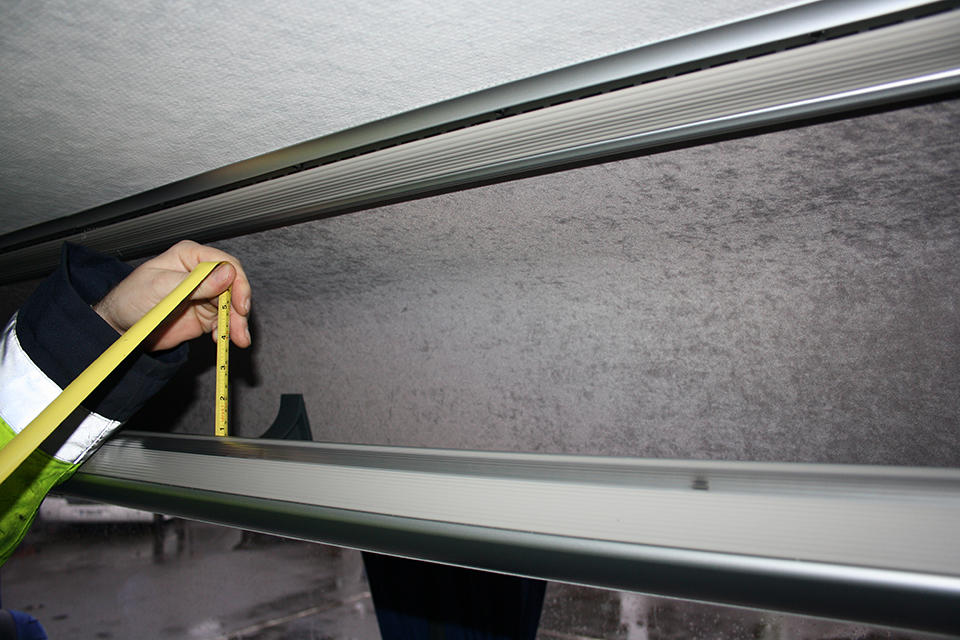
Allowed: A lip to stop luggage becoming dislodged.
The occupants must be protected from falling baggage. In the image above there is a lip to stop luggage becoming dislodged.
Section 52w - trap doors

Trap doors must be secure and not project more than 8mm.
trap doors that aren’t escape hatches, must:
- be secure
- not project by more than 8mm
- have any projections rounded off
Section 52x - visual entertainment

Visual entertainment screens must be located out of the drivers view.

Visual entertainment screens must be located out of the drivers view.
All visual entertainment screens must be located out of the drivers view, when the driver is seated in the normal driving position.
Section 52z - access for passengers with reduced mobility
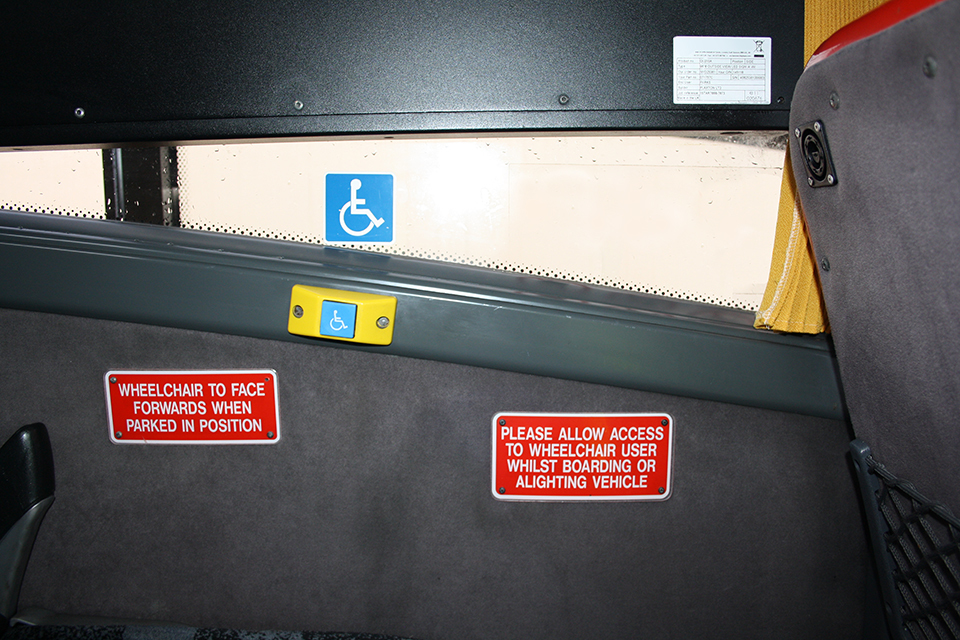
Access for passengers with reduced mobility.

Access for passengers with reduced mobility.
DVSA will use a reference wheelchair to check dimensions and fittings.
Even for those vehicles that don’t require an Accessibility Certificate, any features fitted in the vehicle to facilitate access by passengers with reduced mobility must comply with the relevant requirements of this section.
This is a complex area and each bus or coach type will have different requirements.
To help you meet the required standard, section 52z (access for passengers with reduced mobility) of the IVA inspection manual has:
- notes
- figures
- annexes
- diagrams and drawings
It’s important to read the definitions section of section 52 of the IVA inspection manual. There is a glossary of terms at the back of the manual that will also help.
1.2 What to check when section 52 is inspected
Section 52 covers a large number of items that are inspected.
It’s important that you define what class your bus or coach is. This is explained in section 52 (scope and definitions) of the IVA inspection manual.
Once you know the class of your bus or coach each area of section 52 will list at the start of the section the classes that the section refers to.
For example, section 52b (strength of superstructure) is only applicable to M2 and M3 class II and III single decker vehicles, whereas section 52d (markings) applies to all classes.
Some areas of section 52 will have different inspections and required standards for the different bus and coach types.
It’s important that you define the class of your bus or coach correctly.
Certain sections are covered by documentary evidence, whilst others are covered by inspection, present with the correct paperwork.
For example, section 52a (tilt) demands satisfactory documentary evidence as DVSA won’t carry out a tilt test as part of the IVA examination, where 52e (protection against fire risks) is a section where the examiner will physically examine the vehicle.
Check each area in section 52 and make sure your bus or coach is compliant with the required standards.
1.3 The standard section 52 must meet
See section 52 of the IVA inspection manual for the full inspection standard.
2. Headlamp aim
2.1 How headlamp aim is inspected
Headlamp aim for IVA uses exactly the same European criteria as that for annual test.
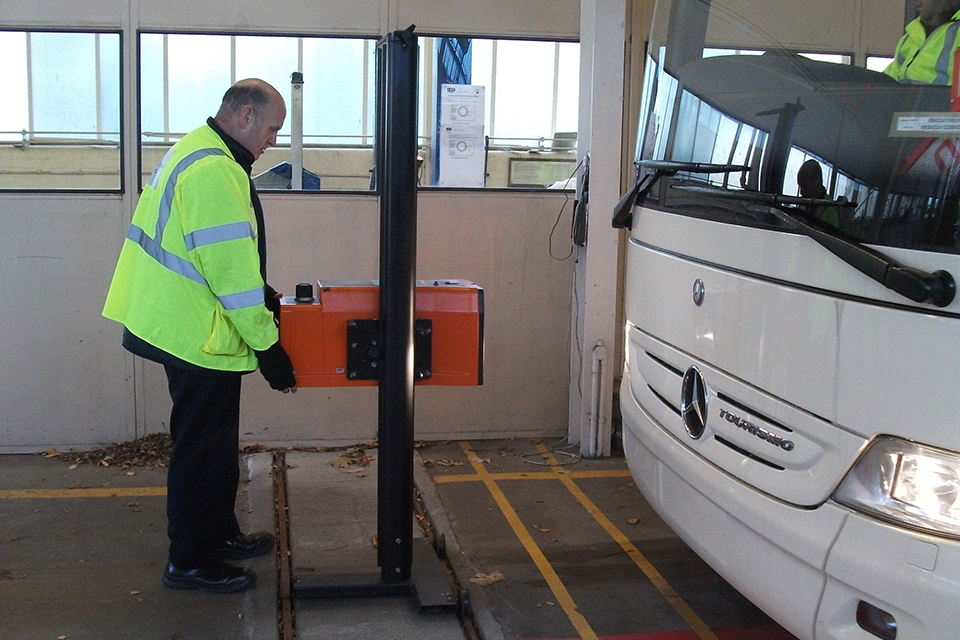
Headlamp aim will be checked using an approved headlamp aim tester.
The headlamp aim will be checked using an approved headlamp aim tester. As part of the inspection DVSA will check for correct:
- image
- height and horizontal aim
- dipping to the left
- a European type pattern

Image of an incorrect and correct ouput.
The images above show an incorrect and correct output.
The headlamp aim in the incorrect example doesn’t provide a clear image to allow the headlamp aim to be checked.
The correct example shows what your vehicle needs:
- a good clear image
- the ‘cut off’ to the left
- correct alignment
- a European type image

Vehicle must be marked with the headlamp recommended manufacturers vertical setting.
As shown in the image above the vehicle must be marked with the headlamp vertical setting recommended by the manufacturer.
2.2 What to check before headlamp aim is inspected
Make sure that your headlamps dip the correct way for driving on the left.
You might need to have headlamps on vehicles imported from countries that drive on the right converted or replaced before the inspection.
Only European type headlamps are allowed for IVA.
Have the headlamp aim checked with a calibrated headlamp aim tester before the inspection.
A voluntary headlamp aim test at an Authorised Test Facility (ATF) can check and allow adjustment of the headlamps if you don’t have the equipment. You’ll need to contact the ATF to make sure that they can provide the check.
The IVA inspection doesn’t allow any kind of internal or external ‘masking’ of the headlamp.
2.3 The standard headlamp aim must meet
See section 25 (headlamps) of the IVA inspection manual for the full inspection standard.
3. General construction
3.1 How general construction is inspected
All aspects of design and construction are inspected to make sure that the vehicle is of no danger to the driver, passengers or other road users.
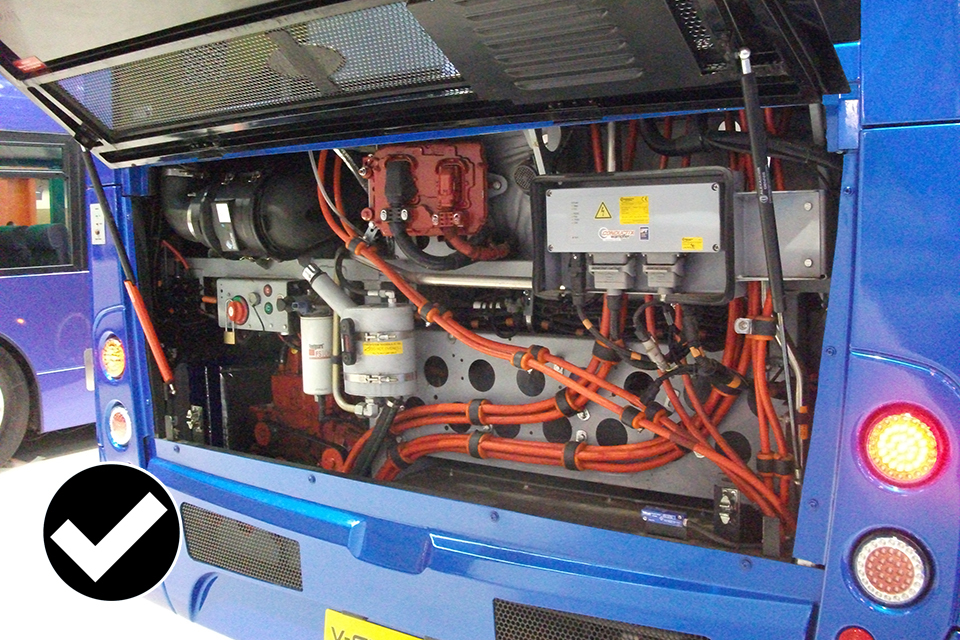
An example of good design and construction.
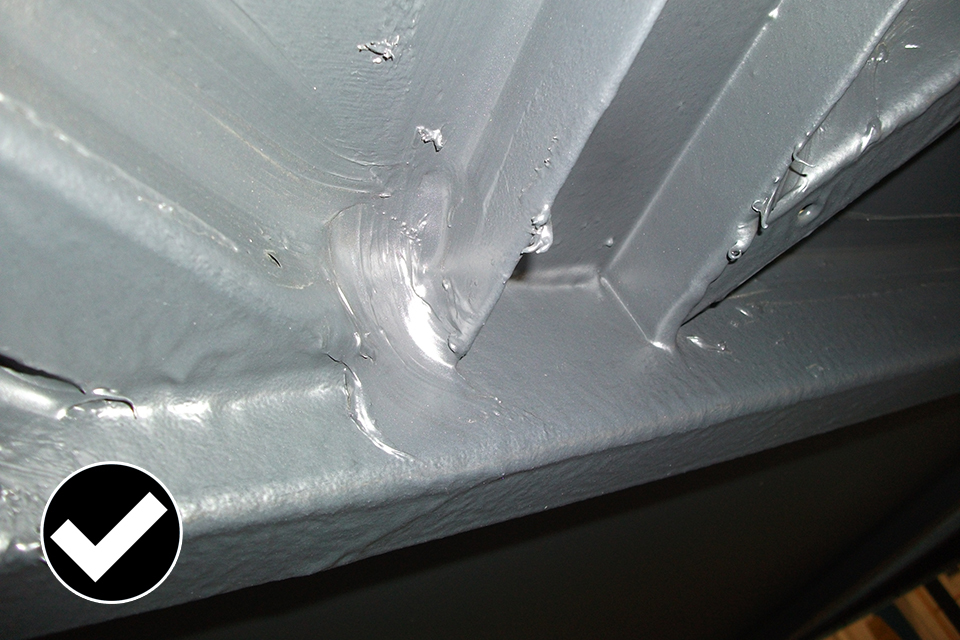
An example of good design and construction.
The images are above are good examples of design and construction where:
- there is professional build quality
- adequate size nuts and bolts have been used
- there is secured wiring and pipeing
- there is good quality welding
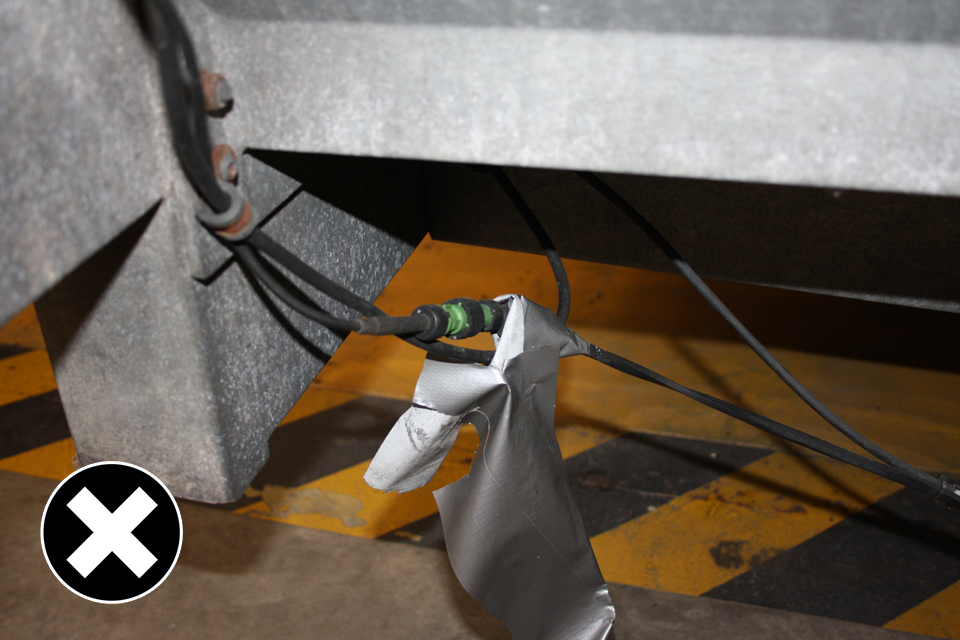
Not allowed: insecure wires that are likely to rub through.
The above image shows an example of insecure wires that are likely to rub through on the metal edge. This isn’t allowed and requires that they are refitted and secured to meet the required standard.
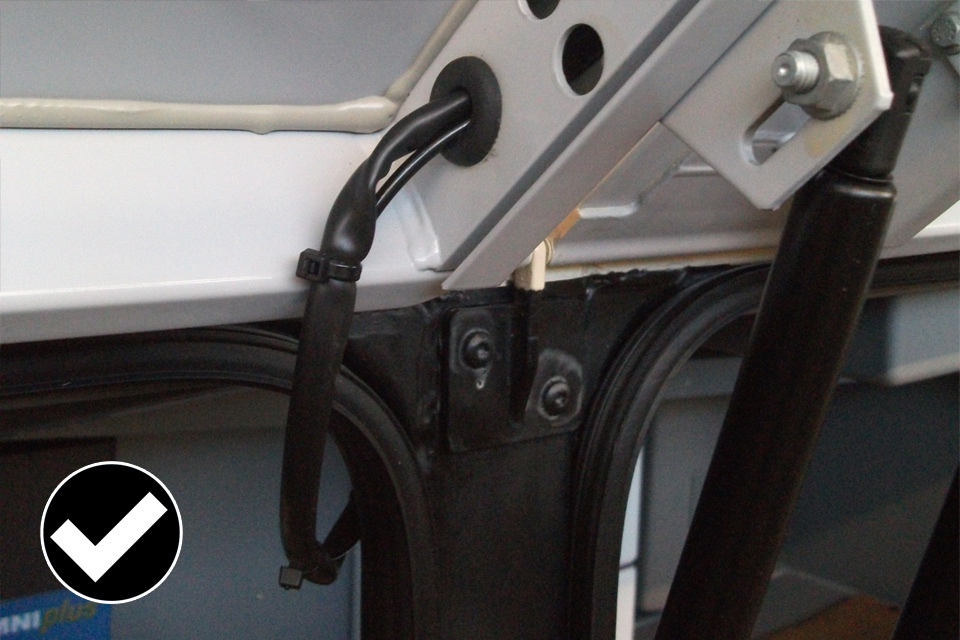
Allowed: good example of wires that are clipped in and grometed.
The above image is a good example of wires that are clipped in and grometed.

Not allowed: insecure wires.
Most common problem DVSA sees for IVA is insecure wiring and piping. The underside of a bus will have a lot of pipe work and cables.
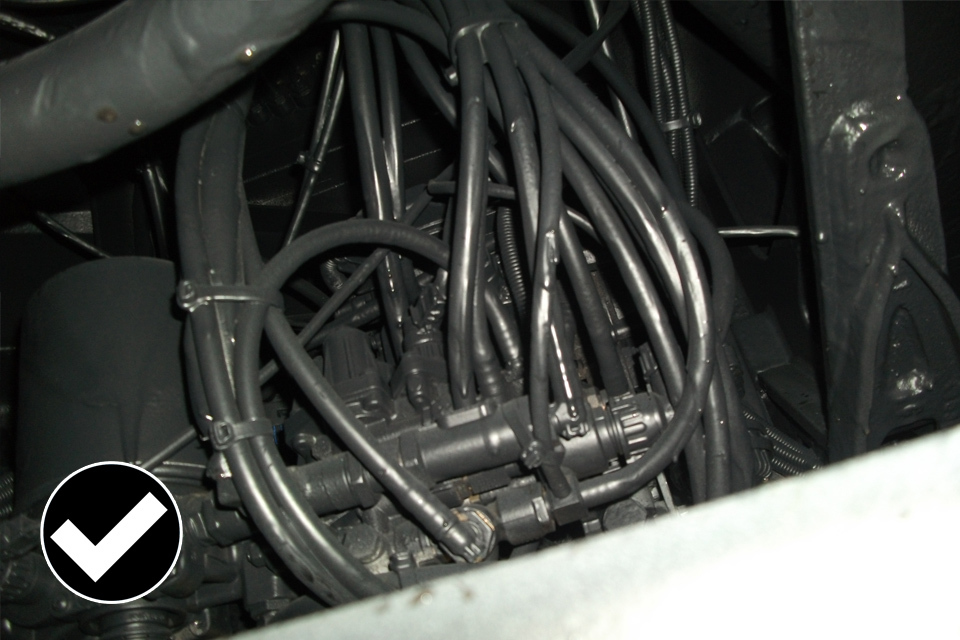
Allowed: good example of secure wiring.
Wiring and piping needs to be secure, clipped into place every 300mm, or in trunking.
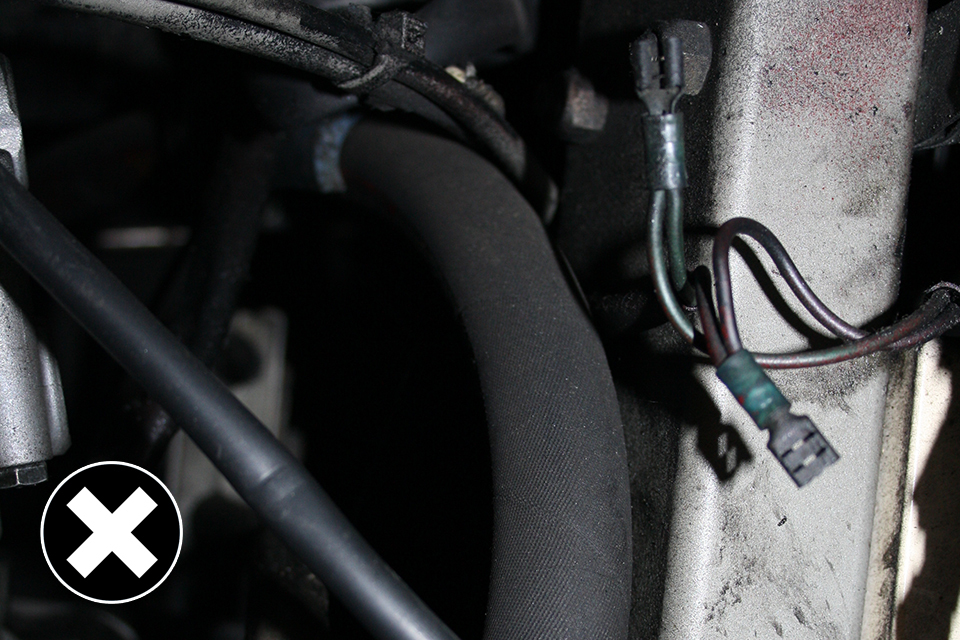
Not allowed: uninsulated and insecure wires.
The image above shows uninsulated and insecure wires, this isn’t allowed.
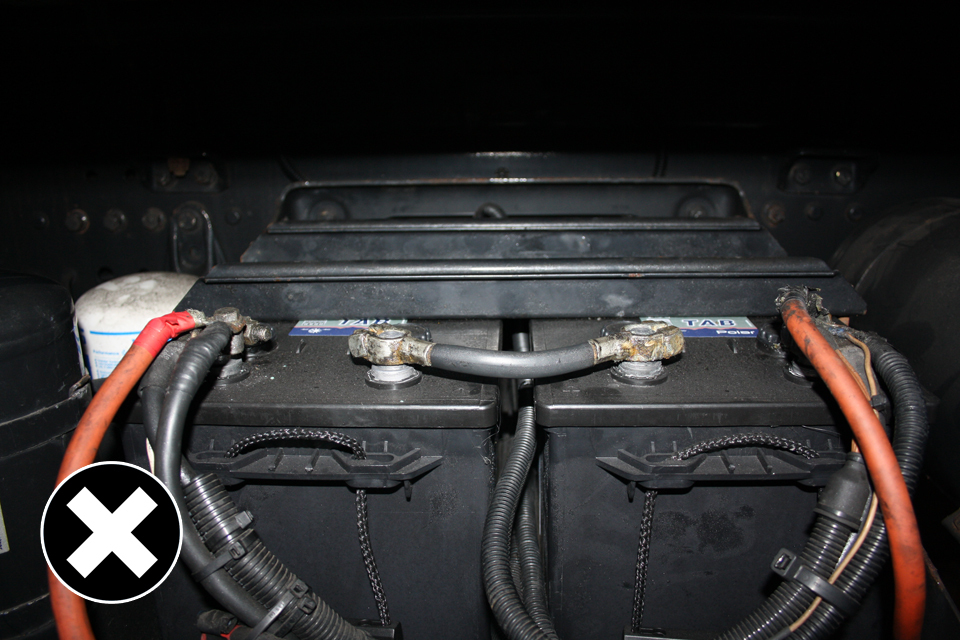
Not allowed: there is no battery terminal insulation.
The image above shows that there is no battery terminal insulation, this isn’t allowed.
3.2 What to check before general construction is inspected
DVSA will look at how the vehicle is designed and constructed and consider all aspects of the vehicle in all the conditions it will be operated under, this includes:
- speed
- load
- vibrations
- acceleration
- cornering
- braking forces
3.3 The standard general construction must meet
See the IVA inspection manual for the full inspection standard.
4. Statutory plates and Vehicle Identification Number (VIN)
4.1 How statutory plates and VIN are inspected
A statutory plate must be fitted for each stage of the build of your vehicle.
Some of the example plates in this section are from a heavy goods vehicle, but the same principles apply to trailers.
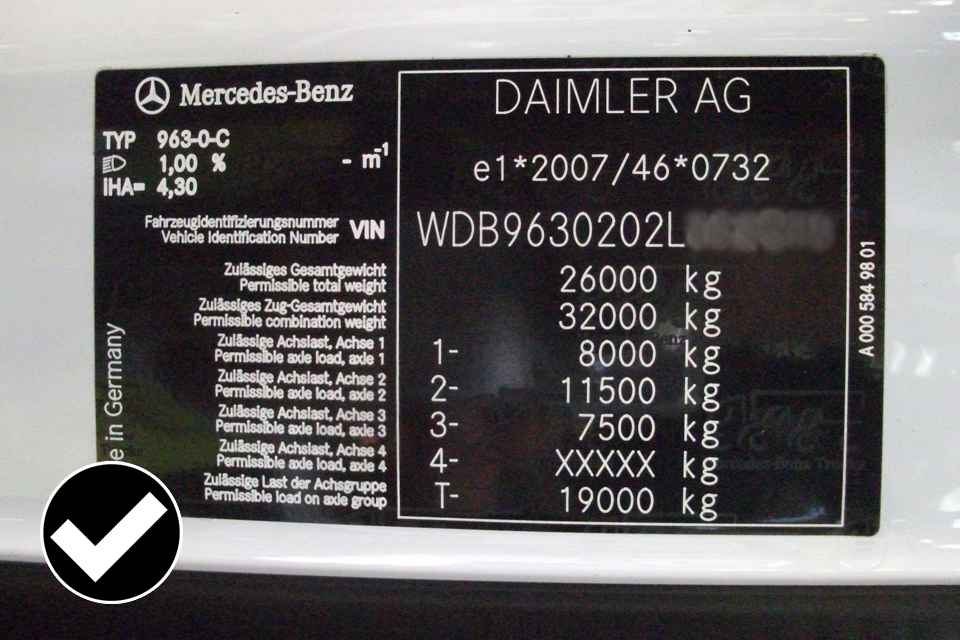
Example of a first stage plate.
The image above is an example of a first stage build.

Example of a second stage plate.
The image above is an example of a second stage build.
The first image shows a first stage plate where all the required information is in a clearly defined rectangle in the correct order.
The second image shows a second stage plate where all the required information has been hand stamped in the correct order in a rectangle.
There is other information on the example plates but as it’s outside the rectangle it’s allowed and both VIN plates are securely fixed to the vehicle.
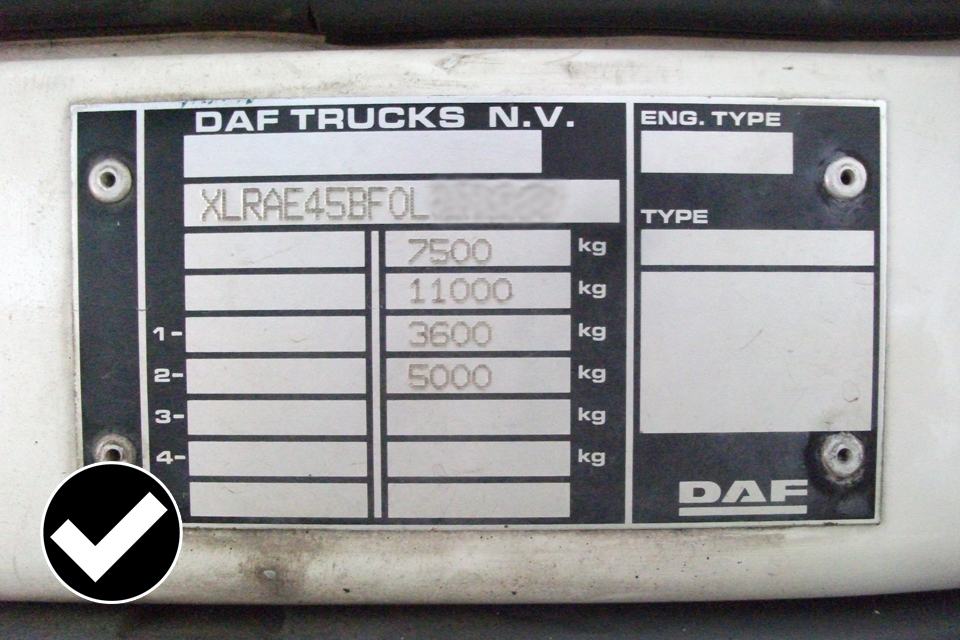
Example of plate with weights in the order that legislation requires.
The image above shows a stage one plate where the plate lists the weights in the order that the legislation requires. This means that the plate doesn’t have to define what they are and works in any language.
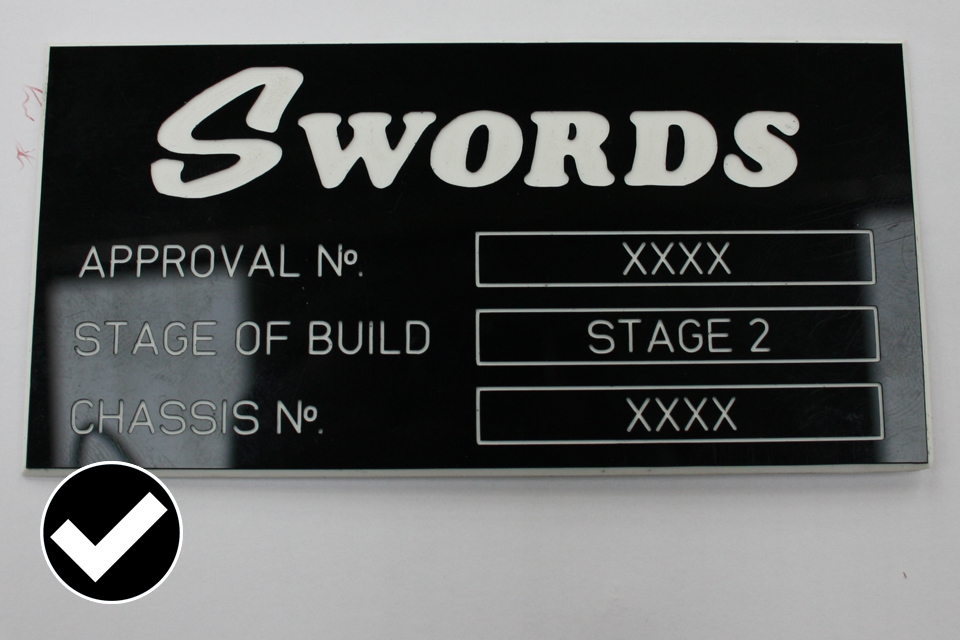
Example of a stage one weights haven't been altered so there is no requirement to list the weights.
The image above is an example where the stage one weights haven’t been altered so there is no requirement to list the weights.
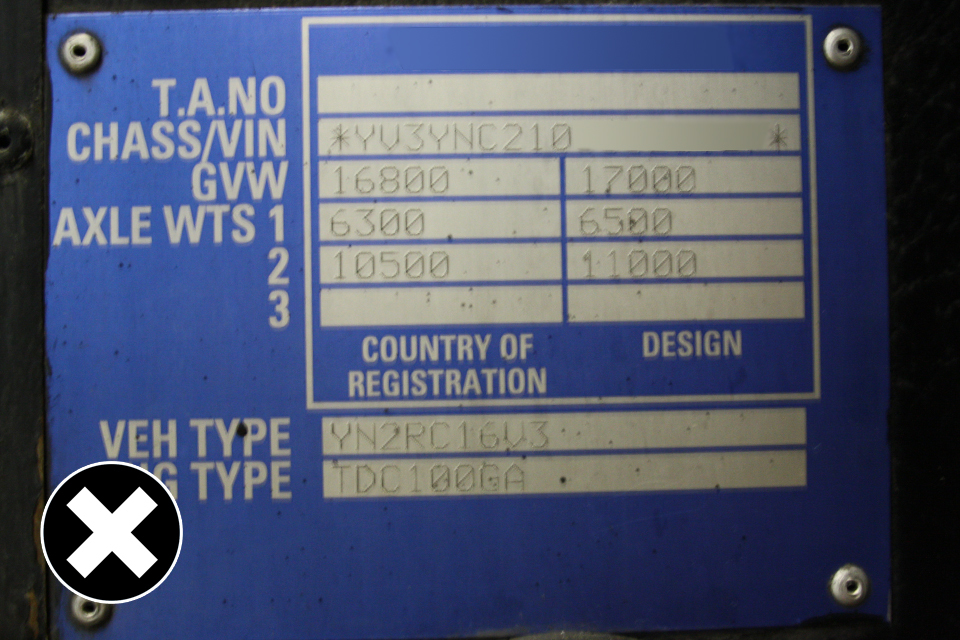
Not allowed: information that isn't allowed inside rectangle.
The image above shows a plate from an older vehicle, all the information is inside a rectangle but the rectangle also contains other information. This isn’t allowed.
DVSA will accept a plate that is approved to a higher or later directive/regulation.
A ‘stamped in’ VIN must be:
- marked on the chassis or frame
- permanent (stamped, hammered, etched)
4.2 What to check before statutory plates and VIN are inspected
The plate must:
- be permanent
- be durable
- contain the required information in the correct order
The only information allowed on the plate must be within a clearly defined rectangle and in the correct order.
The order is:
- name of manufacturer
- approval number and/or build stage (if applicable)
- VIN
- maximum permitted laden mass of vehicle
- maximum train weight (if applicable)
- maximum laden mass for each axle in order from front to rear
There may be other information on the plate but this must be outside of the clearly defined rectangle.
4.3 The standard statutory plates and VIN must meet
See section 18 (statutory plates) of the IVA inspection manual for the full inspection standard.
5. Masses and dimensions
5.1 How masses and dimensions are inspected
DVSA will use a calculation/spreadsheet to work out the whether the vehicle exceeds the manufactures permitted gross vehicle weight(GVW).

DVSA will measure the width, height and length of the vehicle.
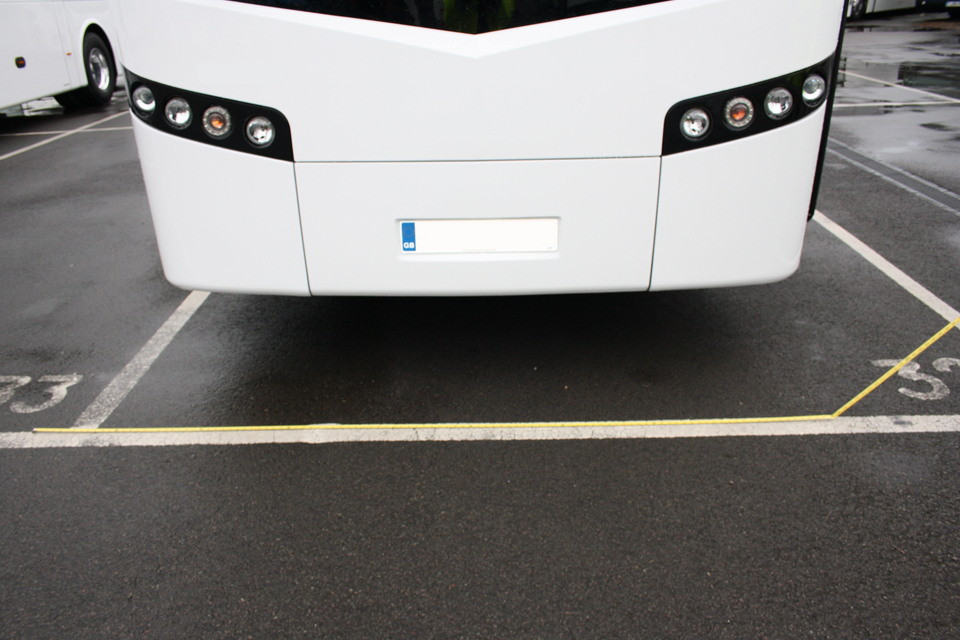
DVSA will measure the width, height and length of the vehicle.
Where a vehicle is considered to be close to the dimension limits, DVSA will measure the:
- width
- height
- length
Maximum lengths differ with the amount of axles fitted and if the bus is articulated.
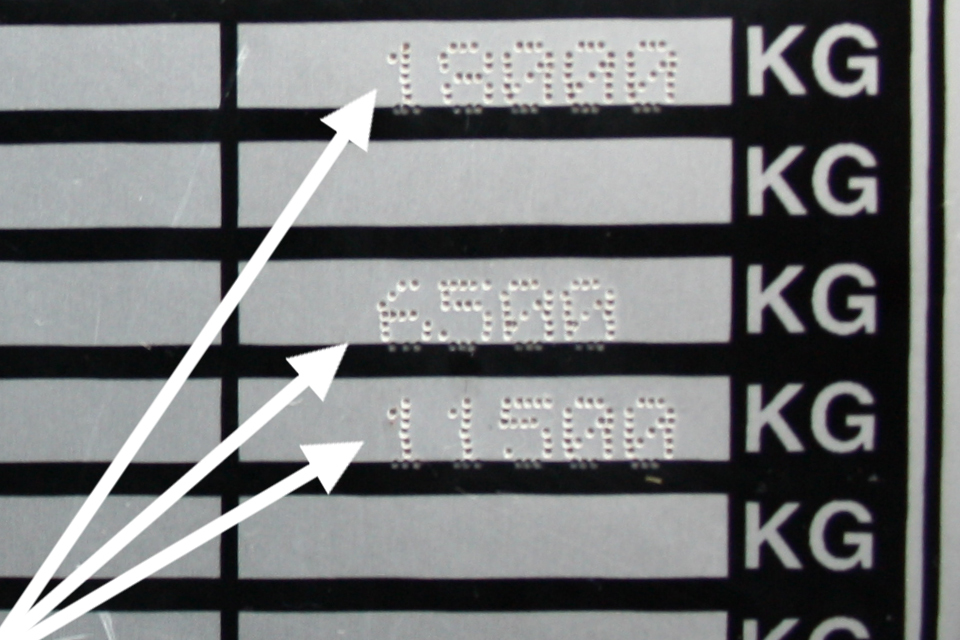
DVSA will check that the sum of the axle weights are equal to or greater than the maximum gross vehicle weight.
As shown in the image above, DVSA will check that the sum of the axle weights are equal to or greater than the maximum GVW.
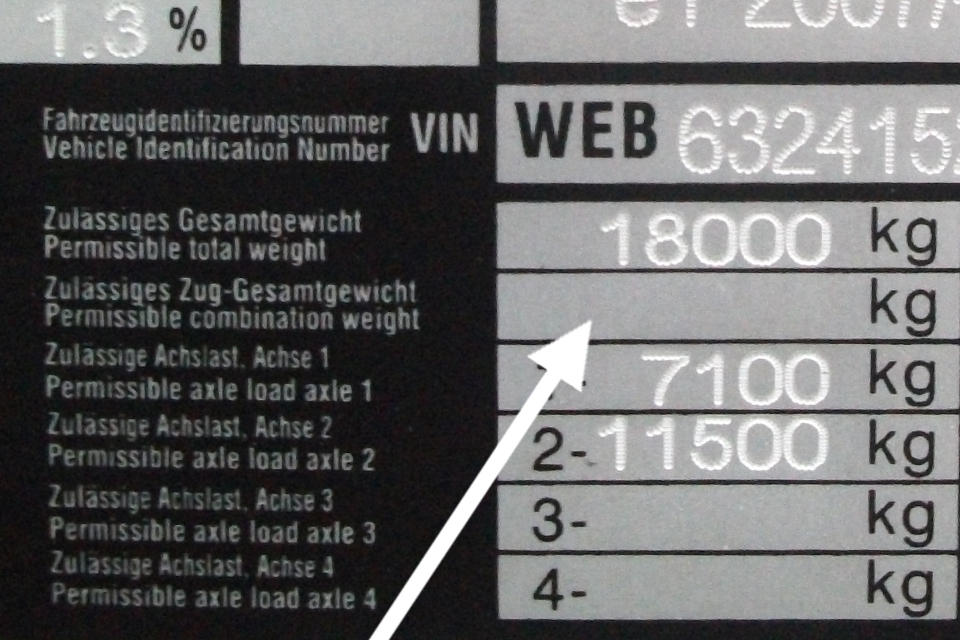
If the bus is equiped to tow a trailer the combination weight must be listed and mustn't exceed 3500 kg.
The image above shows that if the bus is equipped to tow a trailer, then the combination weight must be listed, and mustn’t exceed 3500kg.
5.2 What to check before masses and dimensions are inspected
DVSA will check the declared weights are acceptable for the UK.
DVSA will require evidence that the axles will take the load, if the original axle design weight appears to have been exceeded. For example, a stretched limousine.
DVSA will use a pro-forma calculation to check the bus or coach can carry the amount of passengers and luggage declared. Commercial versions to calculate this may be available or you can calculate them by hand.
A weight certificate of the mass ‘in running order’, which shows axle weights, must be supplied at time of test.
Two columns will be required on the statutory plate if gross design weight (GDW) is greater than the Great Britain (GB) maximum weights. The GB column will need to be on the left.
A turning circle test may be required if the vehicle wheelbase or length appears to have been increased.
The IVA inspection manual lists length and width exemptions for buses and coaches.
5.3 The standard masses and dimensions must meet
See section 48 (masses and dimensions) of the IVA inspection manual for the full inspection standard.
6. Seat belt anchorages
6.1 How seat belt anchorages are inspected
Whether an inspection is required depends on the type of seats that are fitted.

Forward facing seats aren't physically checked.
Forward facing seats with seat belts (as shown in the image above) aren’t physically checked. You’ll be required, at the time of the test, to produce documentary evidence that they meet the required standard.
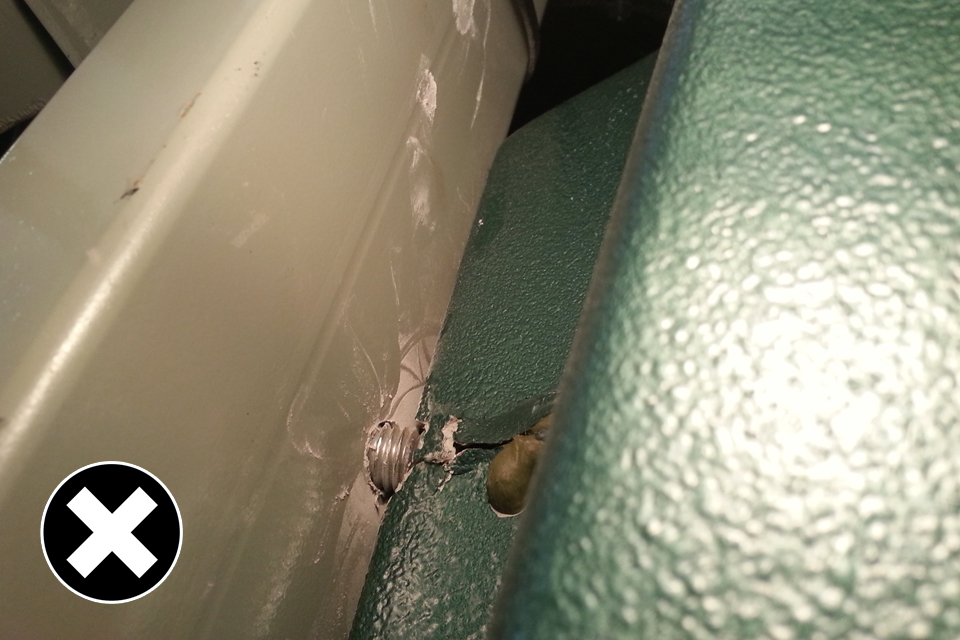
Not allowed: the mounting is inadequate.
For side facing seats, seat belt mountings will be assessed for:
- strength
- suitability
In the image it shows that the mounting is inadequate. It’s simply tapped into a chassis rail with no reinforcement or plates fitted. This isn’t allowed.
6.2 What to check before seat belt anchorages are inspected
For forward and rearward facing seats the vehicle must be accompanied by either:
- documentary evidence that the seat belt mountings comply with an approval
- a test report from an approval authority or recognised test organisation
For sideward facing seats the mountings will be assessed for strength and security of attachment to the vehicle structure.
When you submit the IVA test application you must include forms:
Without these correctly completed no IVA examination will be carried out.
M3 category seat approvals aren’t suitable for an M2 category vehicle.
Prison vehicles, while not requiring seat belts, do require seat belt mountings.
This section should be read in conjunction with the IVA inspection manual:
6.3 The standard seat belt anchorages must meet
See section 19 (seat belt anchorages) of the IVA inspection manual for the full inspection standard.
7. End outline, side, stop & side marker lamps
7.1 How end outline, side, stop & side marker lamps are inspected
This section covers the lamps themselves and the angles of visibility.
Refer to section 22 of the IVA inspection manual for required standards.

DVSA will check the approval marker and identity symbol.

DVSA will check the approval marker and identity symbol.
To make sure each lamp on the vehicle is suitable, DVSA will check for an:
- “E” or “e” approval mark
- correct identity symbol
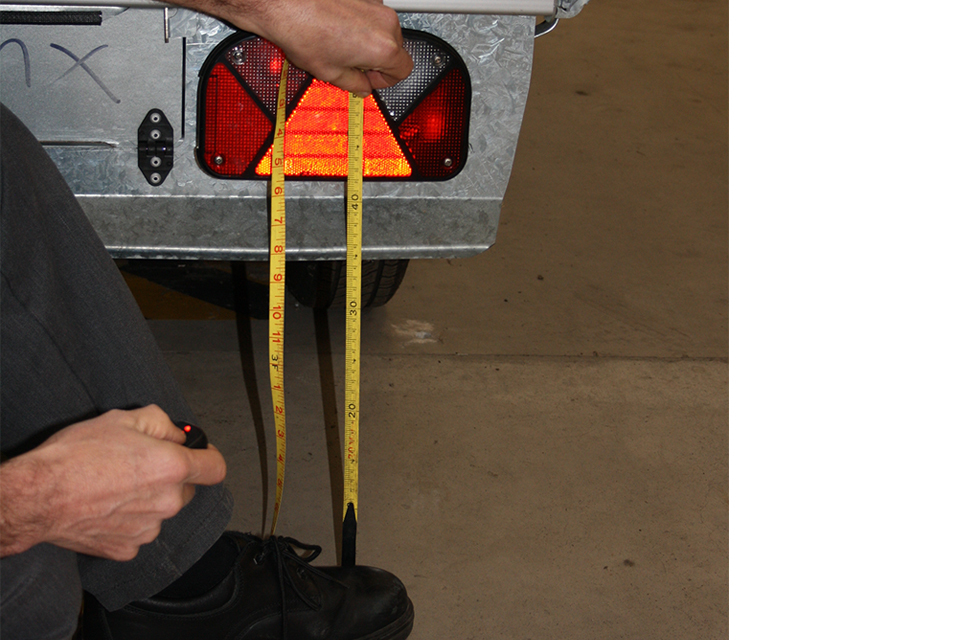
DVSA will check the height from the floor.
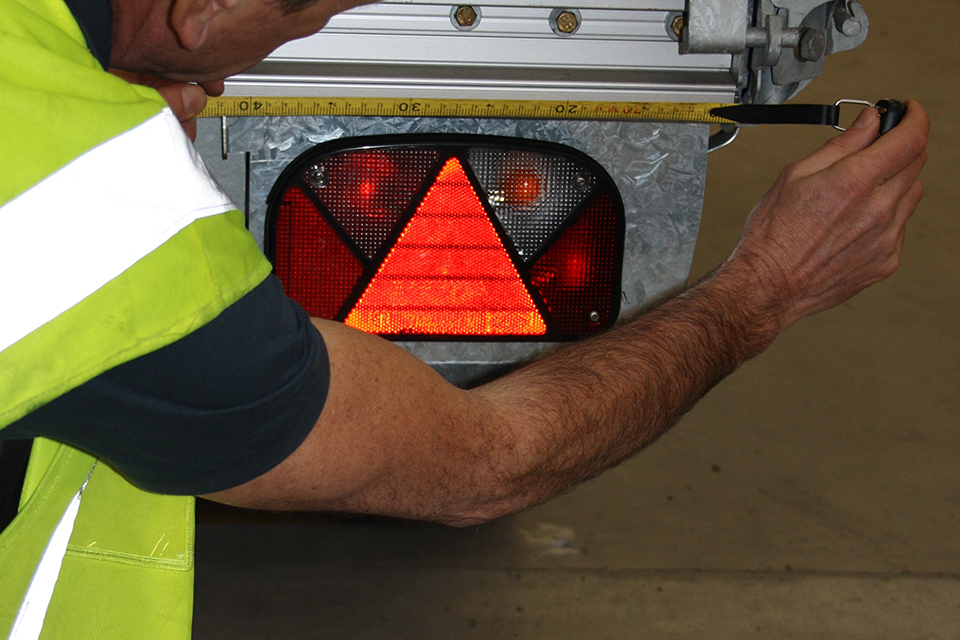
DVSA will check the distance from the side of the vehicle.
DVSA will check side and stop lamps for:
- height from the ground
- distance in from the side of the vehicle
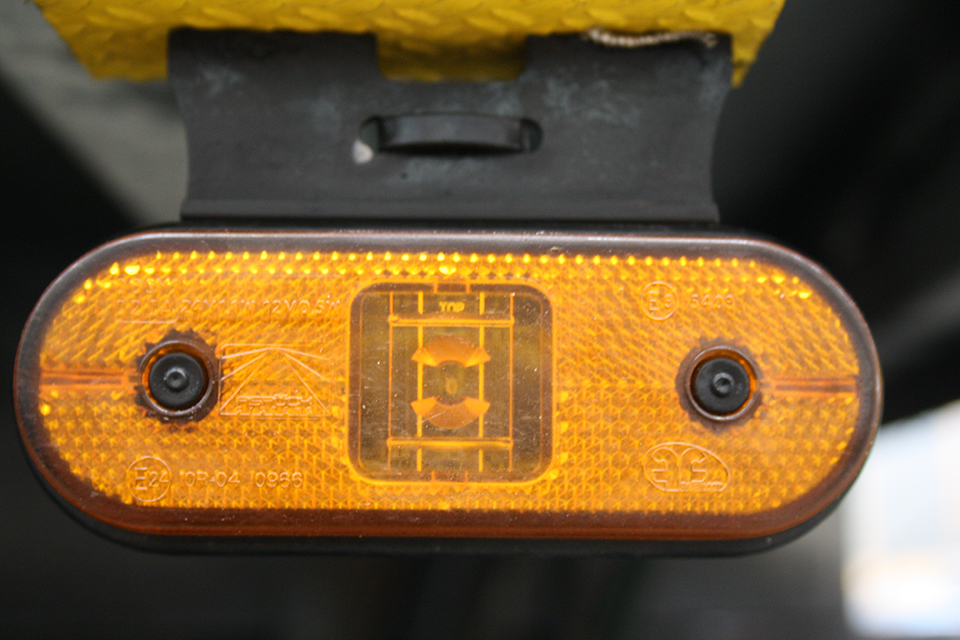
Side markers are checked for correct colour and position.
Side marker lamps are checked for correct:
- colour
- position

An end outline marker must be fitted as high as is practical.
An end outline marker must be fitted as high as is practical.
In the image above it shows that the outline marker is positioned as high as possible. This is correct.
7.2 What to check before end outline, side, stop and side marker lamps are inspected
DVSA will check the lamps fitted to the vehicle for:
- number
- operation
- position
- colour
- required symbols
- required angles of visibility of lamps
- approval mark
Wider or longer vehicles may need end outline and/or side marker lamps.
There is no need to fit special brackets to accommodate end outline lamps if there is no bodywork in the required position.
7.3 The standard end outline, side, stop & side marker lamps must meet
See section 22 (end outline, position(side), stop and side marker lamps) of the IVA inspection manual for the full inspection standard.
8. Seat belts
8.1 How seat belts are inspected
The inspection will depend on:
- the vehicle
- what the seat is used for
- the seat position
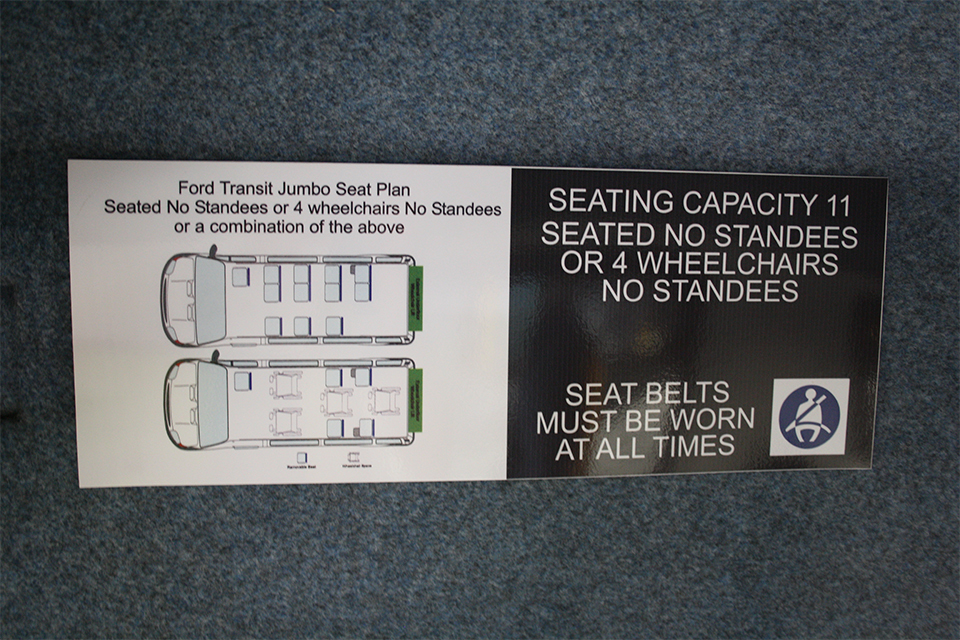
Sign showing the number of passengers allowed to stand and seating position.
The type and amount of seat belts required will depend on:
- the weight of the vehicle
- the number of passengers allowed to stand
Make sure that where seat belts are required, the correct type are fitted.
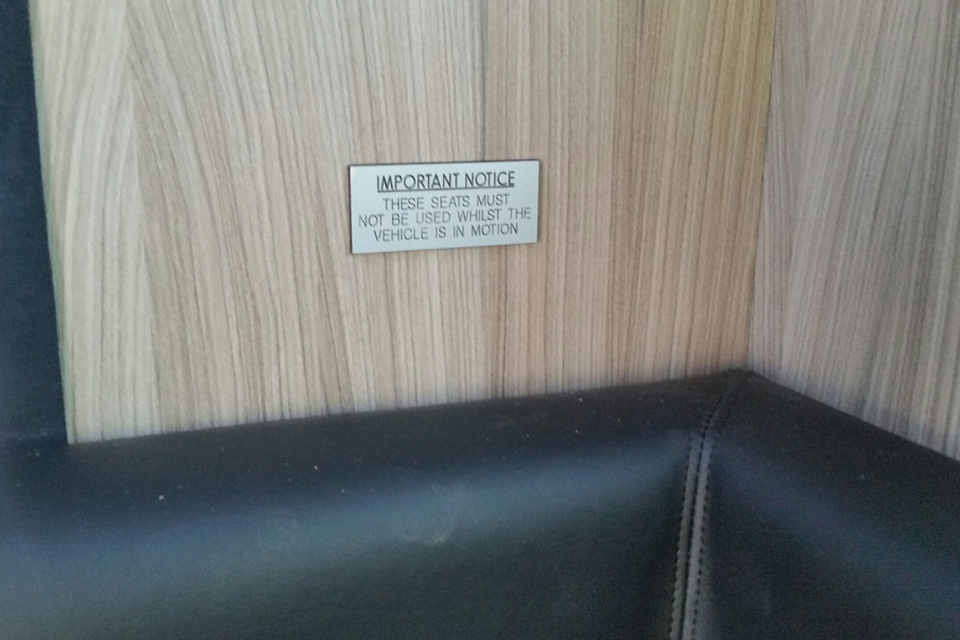
A sign stating that these seats must not be used whilst the vehicle is in motion.
Seat belts aren’t required:
- on seats that aren’t to be used when the vehicle is moving
- for seats that are only used when the vehicle is not used on public roads
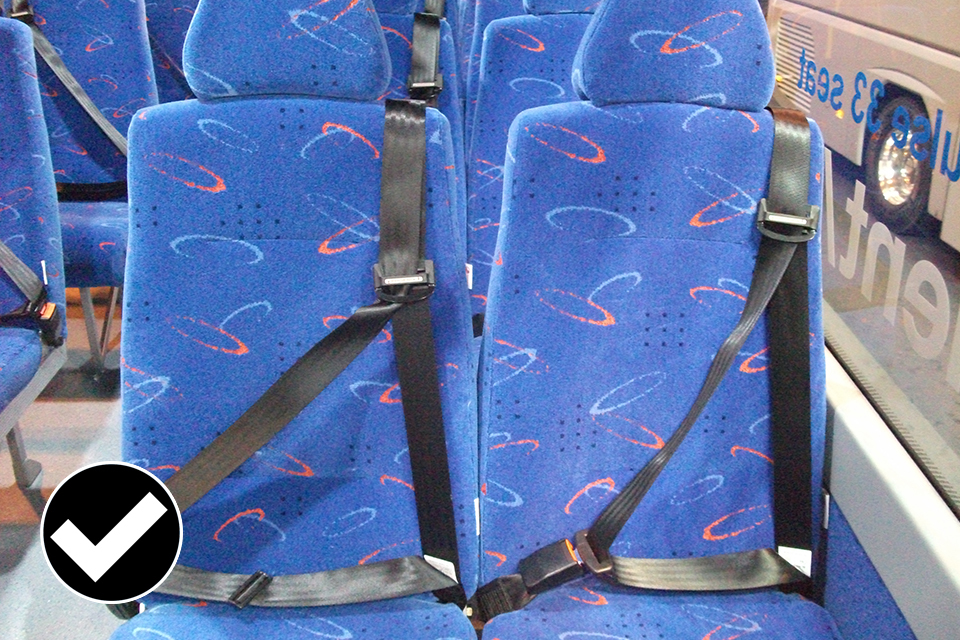
Image showing a correct use of seat belt types.
Seat belts will be checked for:
- correct type
- approval marking
- security of fitting
- damage
- locking mechanism
- retracting
- correct fitting to torso
- sharp edges that may damage the belt
- correct dimensions of mountings
8.2 What to check before seat belts are inspected
For driver, forward, rearward and side facing seats the requirements are different. See section 31 of the IVA inspection manual for the different requirements.
DVSA will check:
- the heights of the upper mounting of the seat belt
- for the appropriate fitted label where seats aren’t for road use
- where the seat belt is fitted to the seat, that it’s an approved seat and the accompanied documentary evidence is correct
Forms 19a and 19b seat belt anchorage compliance must be submitted with your application form. The IVA examination won’t be done without these correctly completed forms.
This section should be read in conjunction with the IVA inspection manual:
Seat approvals for buses and coaches that are over 5 tonne (M3) aren’t suitable for a vehicle 5 tonne or under (M2).
Prison vehicles require seat belt mountings but won’t require seat belts.
8.3 The standard seat belts must meet
See section 31 (seat belts) of the IVA Inspection manual for the full inspection standard.
9. Speed limiter
9.1 How speed limiter is tested
This is applicable to all buses, coaches and other vehicles in the M2 and M3 categories.
Vehicles that are incapable of reaching 100kph by design will require documentary evidence to prove this.
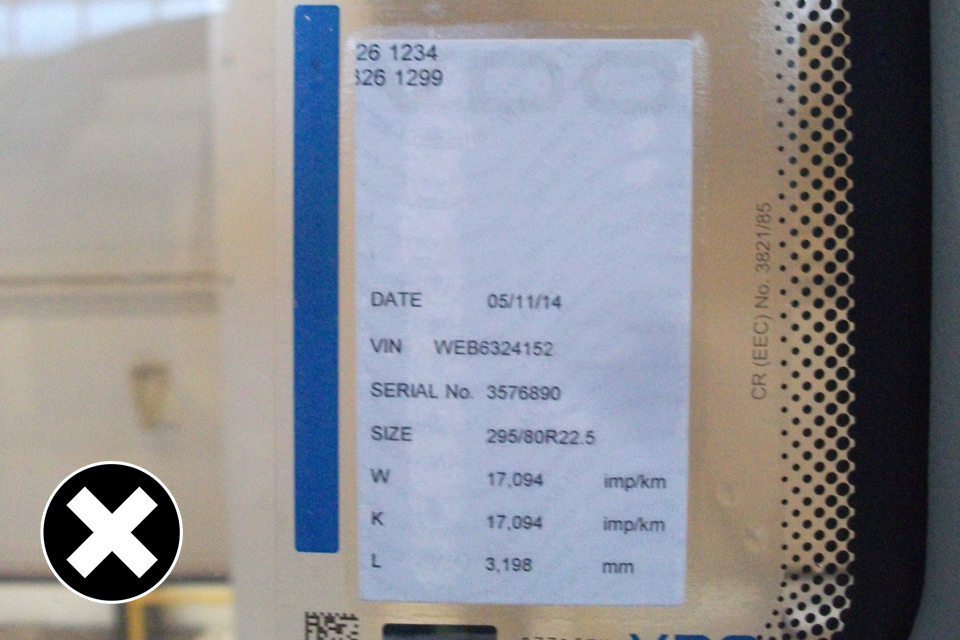
Not allowed: there is no mention of the set speed and is a print out and not a plaque.
The image above is just a calibration printout, not the plaque. There is no mention of the set speed. This isn’t allowed.

Not allowed: all the information has faded away.
In the image above all the information has faded away. This isn’t allowed.
The plaque must be indelibly marked.
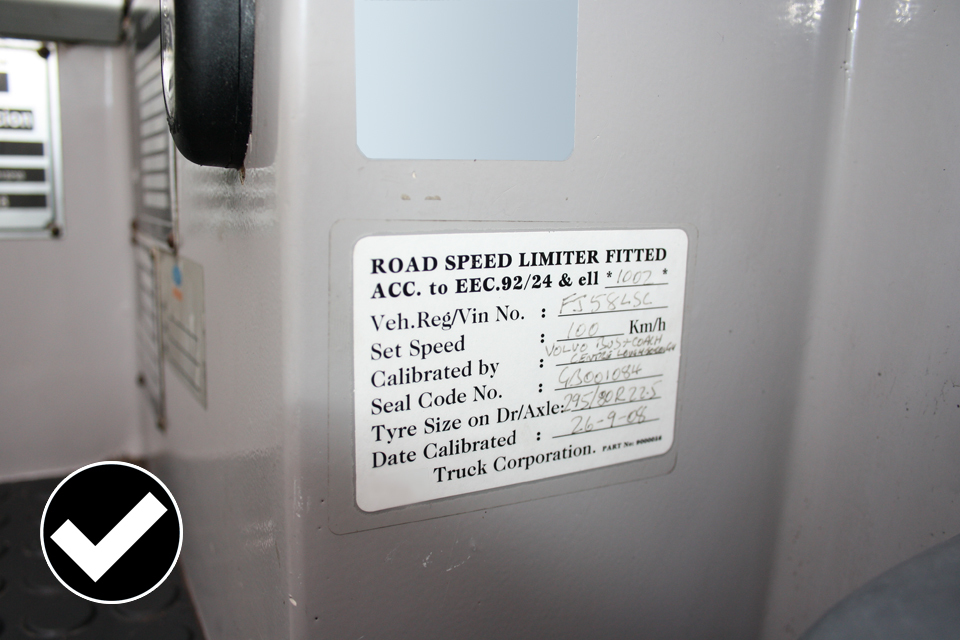
Allowed: the speed limiter plaque must be fitted to the drivers compartment.
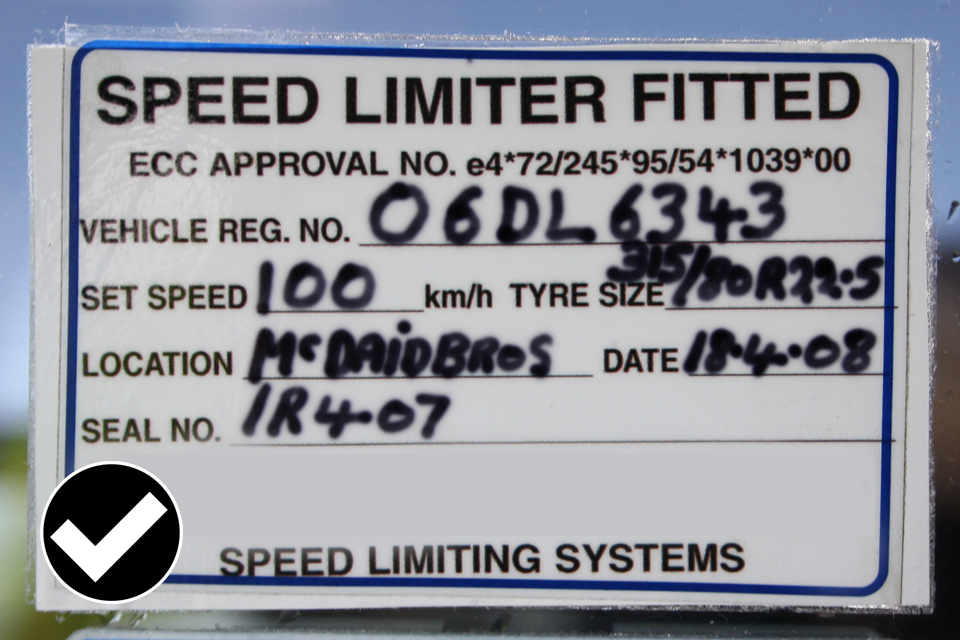
Allowed: the speed limiter plaque fitted to a window must be facing outwards and at the correct height.
The speed limiter plaque must be fitted to the drivers compartment, this could be a door jamb or a window. When fitted to a window it must be:
- facing outwards
- capable of being read by a person of average height
The images above are good examples on how a speed limiter plague can be fitted.
9.2 What to check before speed limiter is inspected
Make sure that a speed limiter is fitted and is sealed or requires special tools for access.
A speed limiter calibration plaque must be securely fitted in the drivers compartment and clearly and indelibly marked with the speed to which it has been set. This can be either 100kph or 62mph.
9.3 The standard speed limiters must meet
See section 47 (speed limiters) of the IVA inspection manual for the full inspection standard.
10. Installation of lights
10.1 How Installation of lights is inspected
All obligatory and optional lamps fitted will be inspected for:
- position
- security
- colour
- orientation
- obstruction
- interaction with other lamps
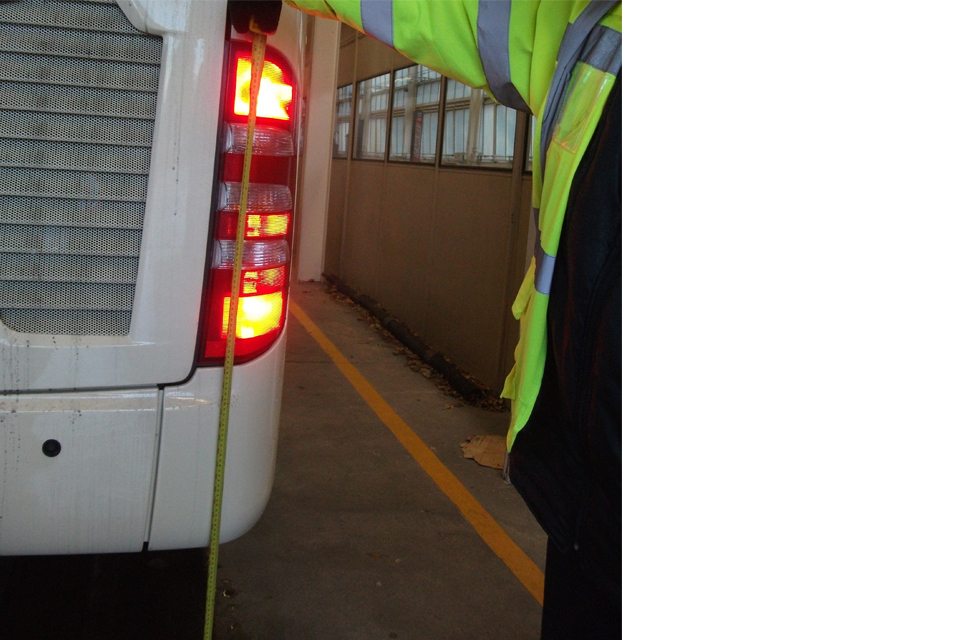
DVSA will measure the height of the lamp.

DVSA will measure the height of the lamp.
The two images above show that DVSA will measure the height and position of the lamp.
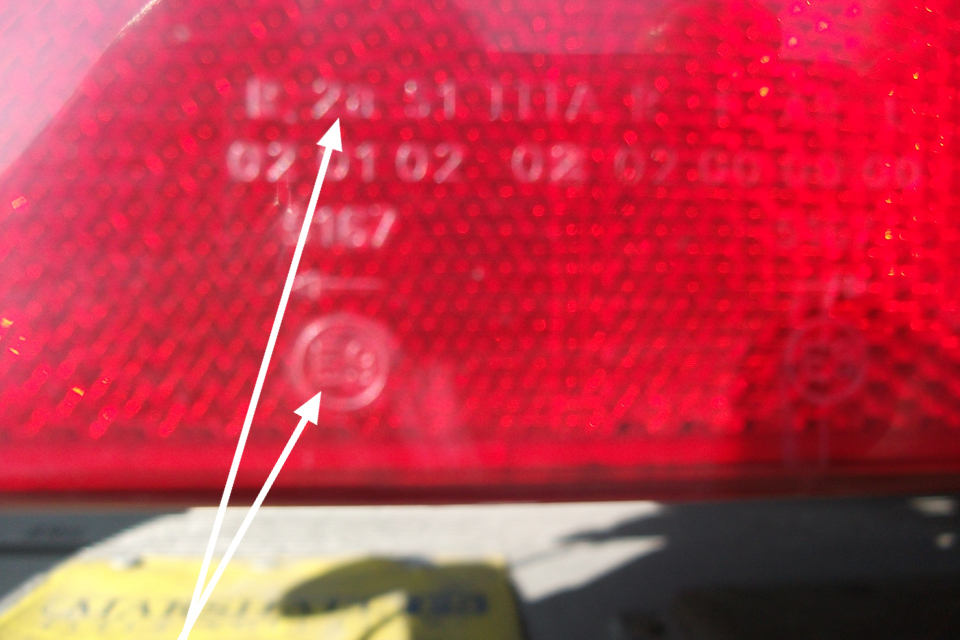
Allowed: image shows an approved lamp.
The image above shows an approved lamp that is marked with both “E” and “e”. The R signifies that it’s a rear position lamp.
In the IVA inspection manual each lamp section lists the relevant identity symbol.
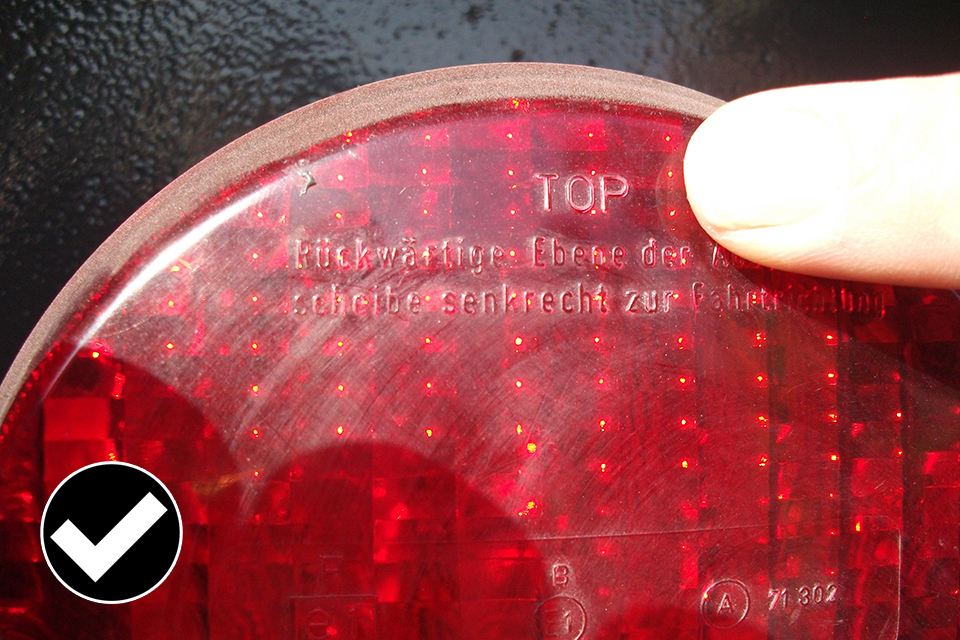
Allowed: lamp fitted in the correct orientation.
The above image shows a lamp which has been fitted in the correct orientation.
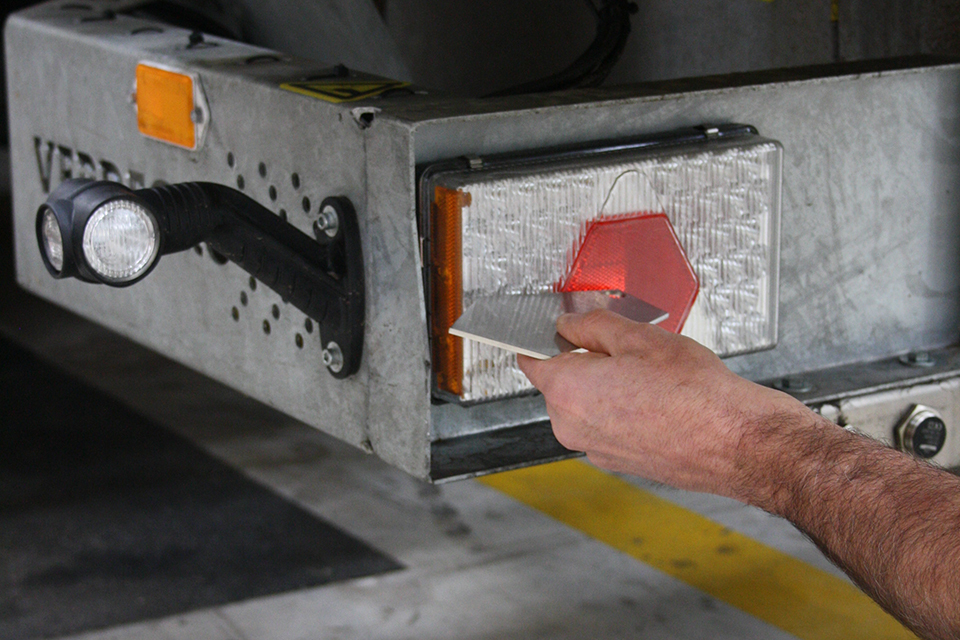
DVSA will use a gauge to check for any obstruction of the angles of visibility.
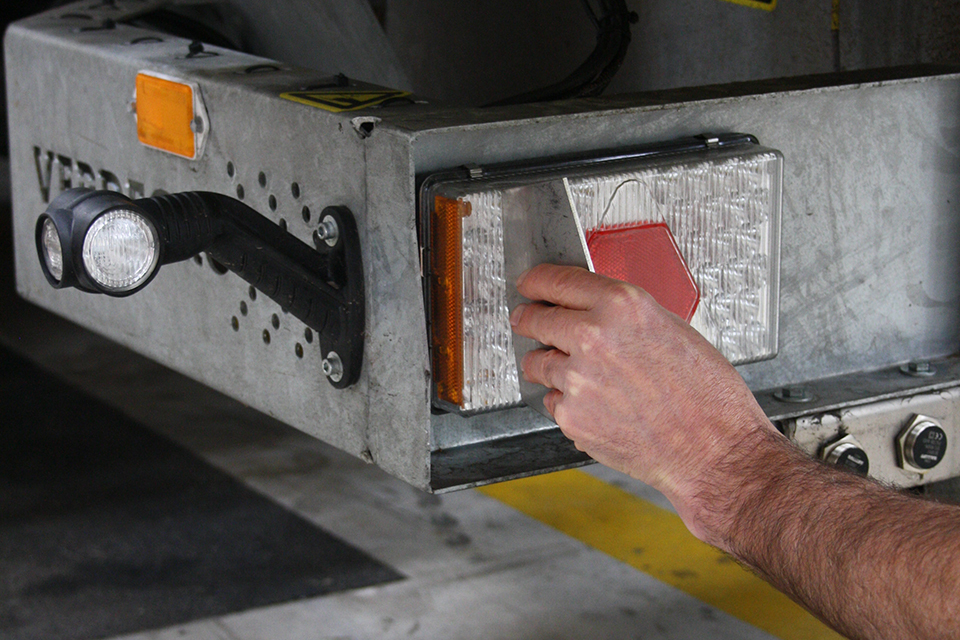
DVSA will use a gauge to check for any obstruction of the angles of visibility.
The angles of visibility are checked to make sure that they’re not obstructed.
As shown in the images above, DVSA will use a gauge to check for any obstruction of the angles of visibility by:
- doors
- access panels
- other obstructions
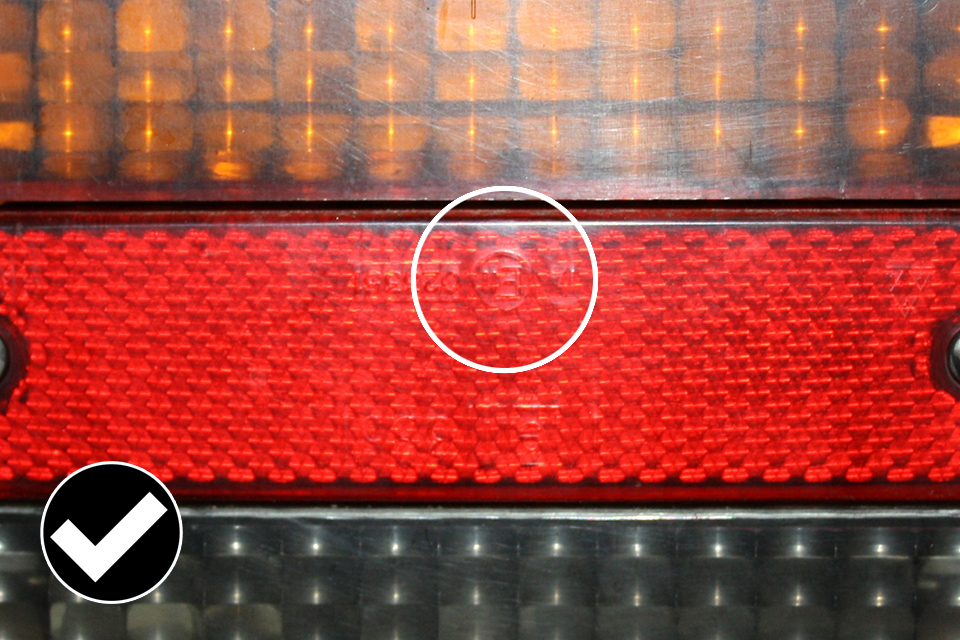
A lamp cluster that contains a reflector will be marked with either IA or IB.
A lamp cluster that contains a reflector will be marked, on the lamp or lens, with either:
- IA
- IB
10.2 What to check before Installation of lights is inspected
All lamps must be fitted the correct way up.
You’ll see that some lamps will have the word ‘TOP’ or an ‘arrow’ on the lamp to indicate the correct orientation.
Follow the figures and charts for each lighting section in the IVA inspection manual. They will give you the correct:
- number
- application
- colour
- position
- angle of visibility
- approval mark (if) required
You can check for obstructions to lamps and reflectors by:
- movable components, lockers, tail lifts, etc
- fixed items such as, towbars, etc
Lights may be partially obscured up to 50% in this way, but reflectors must be visible at all times.
Make sure a reflector is incorporated if you’ve fitted a lamp cluster from another vehicle – not all lamps contain one.
10.3 The standard Installation of lights must meet
See the sections, listed below, of the IVA inspection manual for the full inspection standard:
- section 20 installation of lights
- [section 21 retro reflectors] (/government/admin/publications/387802)
- section 22 end-outline, position (side), stop, side marker and daytime running lamps
- section 23 direction indicators
- section 24 rear registration lamps
- section 25 headlamps
- section 26 front fog lamps
- sections 28 rear fog lamps
- sections 29 reversing lamps
